PointFocus
- Introduction
- The historical origin - San Francisco 1976
- Point Arena, spring of 1977
- San Francisco, summer of 1977
- San Francisco, spring of 1978
- Stockholm, fall 1978 - spring 1979
- Kashmir, summer 1979
- KTH - Konstfack - Hannes Alfvén, fall 1979
- The Sun-or-Uranium Exhibition at the Stockholm Culture Centre, February 1980
- Solar collector course at Lindsberg, July 1980
- Back to mathematics - discovering the beauty of nineteenth century geometry
- Ladakh 1983
- The Solar Steel Plant - Sven Eketorp, KTH 1984
- Tomas Elofsson, Gusum 1985 - 2004
- The Futura trust fund (Stiftelsen Futura) 1987
- Tomas Elofsson's dissemination work
- Tomas Elofsson's correspondence with the Swedish ministery of energy
- Bengt Thorén, Lund 1988
- Allan Ottosson, 1985 -
- Nicaragua February 1989
- Spegeltester i Gusums nedlagda blixtlåsfabrik
- Soft Point Focus, Tryggerstiftelsen 1992
- Solar Horse Power (Soldrivna hästkrafter), Gunnarskog 1995
- Cybermath 2000
Introduction
This is the story of the double cylindrical point focus principle - a truly powerful idea with the potential to change a lot of things in the way we design our technology. It offers a simple and efficient way of concentrating energy from a distant source - most notably the sun - down to a very small volume in space, ideally a point (if the sun were infinitely distant from the earth). Since concentration of energy allows more efficient harnessing of its work-power, and since about a kilowatt-second of solar energy is beaming down on each square-meter of the surface of our earth every second when the sun is shining, the double cylindrical point focus principle contributes to the possibility of designing a more decentralized and sustainable energy technology that will be necessary as our technology evolves beyond its present oil-burning stage.
Naeve, A. Den dubbelcylindriska punktfokusprincipen - en introduktion (PDF)
Clarke, R., Some Utopian Characteristics of Soft Technology
Norberg, L., Har världen råd med Sverige?
The historical origin - San Francisco 1976
On July 1, 1976 I arrived in New Orleans - straight out of India, where I had spent a few months on my newly acquired houseboat - called the Solar Maid - located on the Jhellum river in Srinagar which is the summer capital of Kashmir. Srinagar is located in the shangri-la like Kashmir valley and its Dal Lake hosts an entire society living on house boats and paddling shikaras - a sort of "rural Venice" at 1800 meters above sea level and completely surrounded by the western Himalayan mountains with peaks above 7000 meters. Also, Srinagar is right on the "silk route" between Persia and India, and it is a place loaded with history and myth. A Jewish colony was established here in the 7:th century BC, Alexander the great built a fortress here in the 3:rd century BC and many claim that Jesus Christ spent his youth here (between the age of 12 and 30) and that he returned to Kashmir after his resurrection and lived the rest of his life here. According to these claims, he is buried in Rozabal just outside of Srinagar (Ligger Jesus begravd här?) where it has been guarded by the same family for 2000 years.
Some pictures from Kashmir
 |  |  |  |
 | 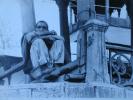 |  |  |
 |  |  |  |
 | 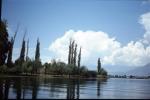 | 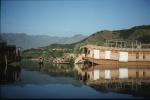 |  |
 | 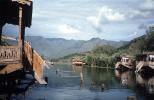 |  | 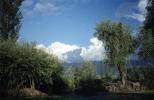 |
 | 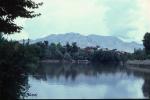 |  | 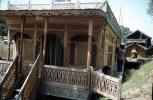 |
| Jhellum river | Maid of the Valley 76 | Maid of the Valley 79 |
 |  |  |  |
| Solar Maid 1 | Solar Maid 2 | Solar Maid 3 | Solar Maid overview |
My plans at the time were to find some suitable lasers and holography producing equipment in the US and bring it back with me to Kashmir, where I was planning to set up a laboratory and start making holograms of Indian deities for the domestic market. Anyone who has experienced the devotion with which an Indian taxi (or lorry) driver decorates his vehicle will understand that this idea is not as far-fetched as it might seem at a first glance.
After taking part of the bi-centennial celebrations of July 4:th and enjoying the famous "southern hospitality" of New Orleans for another three weeks, I travelled westward and arrived in San Francisco by the beginning of August. During the next three months I was busy trying to "build a bridge" between California and Kashmir in various ways. This included helping to organize a trip to Kashmir for a group of American tourists and setting up contacts for import of Kashmir handicraft to California. I was also working on a manuscript for a mathematical philosophy book for children that I had started about a year earlier. During this time, my holography plans were somewhat pushed into the background - although they were always very vivid in the back of my mind. Just a few days before leaving Stockholm in March, I had seen an exhibit with a new kind of white light viewable holographic movies that had filled me with curiousity and inspiration. The exhibit came from the Museum of Holography in New York, and my plans were to go there and find out more about how - and by whom - they were made.
One day I happened to see a holographic movie of this kind at a party given by a friend of a friend. I was extremely happy to learn that the source of these so called Multiplex holograms was a company - called the the Multiplex company - which was located on 454 Shotwell street in the Mission district of San Francisco - just a couple of blocks from where I was staying! The next day I went down to Shotwell street to check out the Multiplex company. In the rather rough warehouse building where it was located I met Michael Kan, who gave me an unforgettable 4 hour lecture on holography. After a while we ended up in Mike's living quarters - a block away from the Multiplex company, where he showed me his electron gun based, high precision surface coating vaccuum device, which he had designed and built entirely by himself, and which was producing the high precision mirror coatings that are crucial for the quality of the holographic process. Mike's place was absolutely packed with more or less disfunctional machinery of various kinds - broken radios, TVs, copiers, etc - equipment that he had obtained from various sources and which he was fixing up or reusing parts from in order to build other things. Mike's place gave the word "tinkering" a whole new dimension of meaning for me!
Michael Kan with his electron gun based, high precision surface coating vaccuum device
 |  |  |  |
| Electron gun | Glass cover | Michael Kan | Vaccuum pump engine |
 |  |
| Turn table 1 | Turn table 2 |
When I returned the following day, Mike introduced me to Lloyd Cross, the inventor of the Multiplex hologram and the major force behind the Multiplex company. Lloyd is a living legend in the holographic community, and he ranks among the principal contributors to the history of holography (in french). In the words of Vicente Carreton of Holonet:
Lloyd Cross conjunctly sums up in his evolution the first two generations of holographers, since he not only has given the medium technological impulses typical of the first one, but in his teachings at San Francisco's School of Holography, which he founded in 1971, he caused a definitive impact in the formation of many key figures of the second one.
Cross, a physicist, was involved in the research of masers and lasers since the end of the fifties. In 1968, together with canadian sculptor Jerry Pethick he invented in Chicago the sandbox system as a vibration insulator and support for the holographic camera, surprising the scientific community with his holograms, at the same time as he surprised the world, organizing the first art holography exhibition at Cranbrook Academy of Arts in Michigan in 1970.
However, in a move that speaks for itself about his ethical integrity, Cross preferred to get away from the research and development of laser-guided armament systems, the research topic at Willow Brook Laboratory at the University of Michigan which he was involved with, in order to take his laser and sound show through New York's small theaters.
After a short stay in Verde Valley (Arizona) with Peter and Ana Maria Nicholson he landed in San Francisco, where he opened his school, the first of this kind in the world, and later founded the Multiplex company, a company to commercially exploit the holographic stereogram technique, or white light integral holograms, invented by him.
The importance of his innovations is augmented by his strategy's generosity and lucidity at putting the new technique within the reach of the civil society, in the hands of artists and aficionados in general, thus liberating the medium from scientific, military and industrial circles and concerns. The hologram The kiss (1974) with Pam Brazier as a model, is one of his classical images, perfected throughout the years and very significative of the type of holograms that were known at that time.
Now, Lloyd is not easily impressed with academic affiliations, but when he learned that I had a house boat in Kashmir and was planning to establish a holographic laboratory up in the Hindukush mountains he became quite interested. We got into talking, and I showed him some pictures from Kashmir and when I described my ideas for a series of holograms of soap-bubbles in wire-frames of the platonic bodies, Lloyd immediately offered me a chance to shoot them in the Multiplex holographic studio. During the next few days we were busy making wire-frames of three of the platonic bodies (the tetrahedron, the cube and the octahedron), finding a good soap-film solution and finally arranging the holographic setup in his sandbox system so that the vibrations from placing the objects in the box would be damped out before the soap film evaporated. The holograms that resulted were quite spectacular!
Cross/Pethic holographic sandbox setup
 |  |
A few days later, when Lloyd learned that I had to find another place to stay, he offered me to move into a part of his personal studio at 550-552 Shotwell street, where he was renting two houses and where he was living together with Sharon McCormack and Michael Kan.
Lloyd's place at 550-552 Shotwell street
 |  |  |  |
| Backstairs 552 | Front 550-552 | Upstairs living area | Lloyd and Sharon |
 |
| Lloyd in his garage lab |
By this time Lloyd and I had found out that we had several common interests, two of them being geometrical optics and solar energy. It turned out that we had both been thinking about using cylindrical mirrors in order to concentrate parallel light rays to a point, and Lloyd had even made an experiment that was quite promising in this respect. Six months earlier I had thought about this problem back in India, but I had let go of it since I felt that if it were possible to achieve a point focus in this simple way, then it would already have been done. But on this point I was soon to prove myself wrong ....
The Mathematical Discovery, November 16, 1976
On this day I discovered the mathematics of the double cylindrical pointfocus configuration and produced the drawing on the left below (Point focus condition). I will never forget the sense of exitement that this insight produced in me. In fact, this exitement has been with me ever since. I remember running into the kitchen and handing the drawing to Lloyd - eagerly explaining why my NASC (Necessary And Sufficient Conditions) for achieving a point focus had to be mathematically correct. My reasoning was the same as that in the drawing to the right (Point focus proof), which contains a formal proof that I produced six months later as a part of my first paper on the Point Focus. Three years later, I produced a version in Swedish called Punktfokus.
 |  |
| Point focus condition | Point focus proof |
The Physical Realization, December 9-12, 1976
Lloyd shared my exitement about the simplicity of the point focus configuration and we now set out to design a double cylindrical "mirror cradle" that exploited this simplicity. Three weeks later we were ready to build it. For the mirrors we used mirror-plex - a kind of clear plastic with back surface aluminum coating. This is a great material to experiment with, since it can be bent, cut with an ordinary saw and handled in various other convenient ways. The mechanics of our construction was based on tension structures - a kind of design that Lloyd had started using a few weeks earlier, and which we - for good reasons - were quite enthusiastic about.
 |
| Tension structure |
A crucial point of our design was the fact that the secondary mirror frame was resting on a rod which marked the focal line of the primary mirror. This gave us a way to tune the primary mirror (by removing the secondary frame) and it gave us a way to move the focal point in space by rotating the secondary frame around this supporting rod. This is one of the three major advantages of the double cylindrical point focus in comparison to the classical parabolic disc. The two other main advantages are (1) that the DC pointfocus is easier to build in large sizes since cylindrical surfaces are curved in only one direction and therefore can be bent (instead of having to be cast into a fixed shape), and (2) that the focal point can be positioned outside of the solar influx area between the mirrors, where it is freely available to perform work.
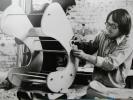 |  |  |  |
| Lloyd adjusting the frame | Mirror cradle | Lloyd | Ambjörn |
 |
| Lloyd and Ambjörn |
The actual building took us three days - and three nights. The pictures above were taken the day after we finished. Besides Lloyd and me, Sharon McCormack and Pam Brazier were also part of the building crew. During this intense work session I even wrote a song about the point focus, which I called Energy is made of Sun and Sand. We finished the mirror cradle in the middle of the night, and in order to test it we clamped a 100 Watt clear light bulb with its filament in the focal point, took the cradle out into the street in front of the lab and switched on the lamp. The effect was stunning. A parallel beam of light shot out from the cradle and we were able to illuminate anything in sight! We knew that we had opened up the windows to a whole new world of possibilities!
Point Arena, spring of 1977
A week after we had finished the mirror cradle I went back to Stockholm to spend Christmas with my family. On the flight I remember being absorbed by the feeling that my life had changed in a very fundamental way. For the first time I really had a mission in life ....
I ended up spending the winter in Sweden and returned to California in the beginning of April. After a long journey, I arrived at the Shotwell studio late at night, and when I stepped through the door the first thing I layed my eyes on was an Oscar statuette sticking out of bag full of clothes. It turned out to belong to Hart Perry, who had just arrived from Los Angeles where he had received an academy award for shooting the documentary Harlan County, USA.
The next day I met Hugh Brady, a writer and an old friend of Lloyd, who had - and still has - a farm just outside of Point Arena, a small coastal town in Mendocino county about three hours drive north of San Francisco along the coast. Hugh was planning to install a solar heating system for his barn, and Lloyd had agreed to help him. So, a few days later, when we had managed to get all the necessary gear loaded onto Lloyd's truck, we found ourselves driving up along the coast - Lloyd, Sharon, Mike and I - on a beatiful clear day. The coast road from Bodega Bay to Fort Bragg is extremely winding and scenic and ranks as a top experience for the motorbikers of America. It was a great experience in an old truck too!
Hugh Brady's plastic tree house
 |  |  |  |  |
| The downstairs greenhouse | Hugh Brady in his study | The piano corner | The stove pipe | Blazing showers |
Up in the Redwood trees, on the edge of the Garcia river, and (almost) on top of the San Andreas fault, Hugh had built himself an amazing house with plastic walls where he was living together with Nancy Dawson and their two kids Baba and Pam. For the next two weeks, this plastic tree house became the base camp for our barn solarizing operation. After breakfast, most of us would walk from the tree house about half a mile across Hugh's land to the barn, where we worked on the solar collectors until lunch. Then we would walk back to the tree house and enjoy the results of Nancy's superb cooking. Then we would walk back to the barn for the afternoon work shift, and then walk back to the tree house again to be re-energized by a great Nancy dinner. We had a wonderful time - having fun in the sun - and I will always admire the way Hugh and Nancy were able to handle all the chaotic energy that we brought into their home - while at the same time handling their two small kids.
Building line collectors at Hugh's barn
 |  |  |  |
| Overview of the barn | The barn inside | Laying out the collectors | Line collector parts |
 |  | 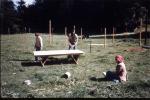 | 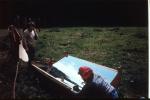 |
| Line focus (3 pipes) | Assembling work table | Lloyd, Ambjörn and Peggy | Lloyd and Peggy |
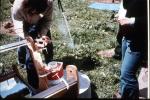 |  |
| Lloyd letting out steam | Tuning the line collector |
The parabolic cylinder line focusing collector is a classical solar collector for heating water (see classical solar collectors). On top of this well-known design, Lloyd added the feature of using three pipes instead of one. This gives a broader absorption area for the focal line, which allows the collector to be repositioned (for re-alignment with the sun) much less frequently. The collector can be left stationary during the day - even around the times of the solstices, when the solar orbit deviates maximally from the planarity that it achieves at the times of the equinoxes.
In the middle of the project David Cort - a friend of Lloyd and Hugh from New York - turned up with his Media Bus - a mobile camping van turned into a video recording studio. David had heard of our point focus work and wanted to make a movie to document some of it. So we de-tooled for a few days and we all turned into actors in David's movie, which is called Focusing the sun - featuring Lloyd Cross and his crew at work. Sharon drew some nice illustrations of the parabolic line- and point focus principles and explained them in the film, Lloyd and I demonstrated a camper's version of the point focus with a string-twisting device that I had designed, and I played the guitar and sang my point focus song. The video is available for rent or purchase online, although the prices are rather ridicoulus. I don't know how many copies that have been sold, but I certainly have not received any actor's commission yet :-)
David Cort making his movie "Focusing the Sun"
 |  |
| Boiling water | David filming Sharon's lecture |
 |
| Lloyd and Ambjörn burning with the camper's point focus |
San Francisco, summer of 1977
So there we were in Point Arena, having fun in the sun, but unfortunately we were not properly funded. The rent for the San Francisco facilities still had to be paid, and when Lloyd suddenly got an offer - backed by a solid budget - to build a new multiplex holographic printer, he had to suspend the solar barn project and leave it unfinished. Of course, the plans were to finish it later, but alas - 26 years later - the solar barn project still remains unfinished.
The printer was commissioned by Larry Lieberman, an artist who worked out of his studio in Columbus, Ohio. Larry came out to San Francisco in his camping van and took part in the building process. For this purpose, Lloyd rented a space in a warehouse on Florida street, a couple of blocks away from his place on Shotwell. The place was owned by a guy called Nathan ????. When he learned about our solar heating project in Point Arena, Nathan wanted to install such collectors on the roof of his warehouse in order to heat the building. However, although we did some preliminary work - which included drilling a few holes through the roof of the building - these plans were never realized.
Multiplex printer - Mark IV
 |  |  |  |
| Cylindrical lense | DC pointfocus back | DC pointfocus front | Lloyd Cross |
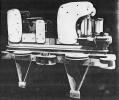 |  |  |  |
| Mark IV printer 1 | Mark IV printer 2 | Michael Kan | Optical bench |
 |
| Sharon McCormack |
The new printer was the fourth version (mark IV) of the kind of holographic movie making machine that Lloyd has invented and developed. The previous version (mark III) was the one in operation at the Multiplex company at the time. The mark III was an improved version of the mark II, which had been built as a result of a commission by Salvador Dali. He was involved in a promotion campain for Alice Cooper, and when he saw a small integral hologram - called Leslie - that Lloyd had created, Salvador got in touch with Lloyd and asked him if he could create a larger version of this kind of hologram featuring Alice Cooper. This provided the funding that eventually led to Lloyd Cross designing the mark II, and he and Michael Kan improving it into the mark III. The holographic movies that came out of the mark III printer were so stunning that they amazed the world and led to the formation of the Multiplex company. A more detailed account of this entire process can be found in a rough draft that was transcribed from a series of taped interviews with Lloyd Cross in 1976. The mark IV printer is described in an article in Holosphere from November 1977.
San Francisco, spring of 1978
During the fall of 1977, I was away from the "Shotwell scene" - spending time with friends up in Oregon and in other parts of the Bay area. Prominent among these friends were Pat Judge, Ellen Dorsey and Pat Willever, who gave me "shelter from the storm" and a place to write up my first paper on the point focus. It was finished in April 1978, while I was staying with Pat Willever at her beautiful house in the Sunset district.
 |  |  |  |
| Front view | Fire place | Ambjorn and Fawn | Writing table |
The wavy strip solar line collector
During this time, Lloyd was working mainly on various holographic projects but when I re-connected with him in April 1978, he had just invented a new kind of solar line collector based on "wavy strips". He had solved a classical problem and found a way of attaching ordinary aluminum foil to a wooden strip in a way that gave the resulting surface enough optical quality to reflect sunlight in a specular (= non-diffusive) way. By covering the strip with tar and using a specially designed roller, he was able to roll out the foil and attach it to the strip in a way that streched the foil in a wavy pattern. Now, since waves (= the thickness of the tar) varied ONLY along the strip - and NOT across it - the reflections from this wavy strip differed from the reflections of a planar strip ONLY in the direction along the strip and NOT in the direction across it. This means that these wavy strips can still keep the sunlight focused along a linear absorber - provided only that this absorber is made somewhat longer than in a classical configuration involving planar strips.
The entire point of this construction is of course the cost. The wavy strip solar line collector offers an extremely cheap way of heating water. In fact, it could be described as a sort of "solar sandbox", since it does for solar energy what the sand box system does for holography - bringing down the cost by orders of magnitude. This is so typical of Lloyd Cross - as well as of Michael Kan. They possess the extremely rare quality of being able to penetrate to the core of a physical process, discover the critical principles that are involved in the process and to design the machinery that will deliver the process in a way that supports its critical principles in a cost effective way.
Wavy strip collector setup and single strip with tool
 |  |  |
| Wavy strip collector 1 | Wavy strip collector 2 | Wavy strip with tool |
 | 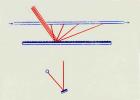 |
| Cross wavy strips 1 | Cross wavy strips 2 |
The wavy strip collector that is depicted above was built by Lloyd's son John Cross who was 12 years old at the time. /////////// SOLAR GYPSY PHILOSOPHY
 |
| Big heat hole |
A larger version of the double cylindrical point focus
During the spring of 1978 we also put together a larger version of the point focus. This version consisted of two separate mirrors without a connecting frame. The mirror frames were also built as tension structures, but they had special controls to adjust the curvature than the first point focus, which had to be adjusted by free hand and clamed in place. The primary mirror measured about 1.5 x 1 m which gave a 1.5 square meter primary surface area.
This point focus machine was demonstrated on the special solar celebration day called Sun Day. We set up the mirrors at Pier 45, where there were several other Sun Day related activities going on, and we melted some copper and scintilated some sand in front of some enthusiastic onlookers.
 | 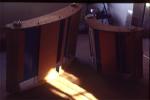 |  |
| Mirrors front | Mirror frames back | Melting copper at Pier 45 on Sun Day, May 3, 1978 |
A few days later, I gave a solar energy lecture at a "sustainable futures conference" at Davies, where I demonstrated the camper's version of the DC point focus. The stars among the invited speakers were Buckminster Fuller and Timothy Leary, and although my talk was only in a poster session, I felt proud to be allowed to spread "the point focus gospel" in such illustrious company. At this time I had been away from academia for almost four years, but now I knew that it was time for me to return to my academic home base at KTH in Stockholm. In contrast to when I left it in 1974, I now knew what I wanted to do there.
 |
| The solar lecture at Davies |
Stockholm, fall 1978 - spring 1979
I got back to Stockholm in July and resumed my mathematics teaching at KTH in September. Apart from my regular math classes, I also started a non-formal special interest class for my students at KTH around the subjects of solar energy and holography. Although the activities were mainly theoretical, I was inspired by the School of holography that Lloyd Cross and Jerry Pethic had created in San Francisco. In the long term I was hoping to establish a sort of "tinkering and innovation centre" at KTH, where students, teachers and administrators that had a common interest in "alternative technology" could come together and work in a non-formal way. I especially saw the possibility of involving retired employees with a lot of experience and free time in these activities.
As the word got around about my adventures in California, I started to get invitations to lecture on solar energy and holography in various places - ranging from Stockholm University to the UFO-society of Köping. Mikael Tsigotsides, Pähr Sällström and Varis Bokalders were among the first to arrange such special invitations. I especially remember a talk at Sandöskolan, which gave courses for SIDA development aid workers. It was titled Eco-logical technology - a creative and sustainable alternative to our eco-no-logical consumption society. Of course, I was hoping to infect SIDA with the DC point focus idea virus, but as we will see, this organization turned out to have an amazingly strong and well developed immune system.
In response to all of these lecture invitations, I prepared a lot of OH-slides on solar energy and holography. The ones that I've managed to retrieve from my non-digital archives are shown below
Solar Energy
 |  |  |  |
| Convex lense | Cylindrical PointFocus 1 | Naive Horizon Cross | Parabola |
 |  |  |  |
| Parabola rays | Parabola translation | Parabolic disc rays | PointFocus Cradle |
 |  |  |
| PointFocus Cradle Rays | PointFocus cyl 1+2 rays | PointFocus cyl 1 rays |
 |
| PointFocus wheelbarrel |
Holography
Basic
 |  |  |  |
| gabor | Hand diffraction | Hologram reconstruct | Hologram record |
 |  |  |
| Superposing waves | Two points interference | Water pointscattered |
Point source
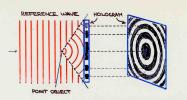 |  |  |
| Point source hologram 1 | Point source hologram 2 | Point source hologram 3 |
Whitelight
 |  |  |
| Denisyuk | Lippman | Rainbow |
Multiplex
 |  |  |
| Multiplex 1 | Multiplex 2 | Multiplex 3 |
 |  | 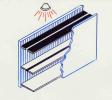 |  |
| Multiplex 4 | Multiplex 5 | Multiplex 6 | Multiplex 7 |
 |  |
| Multiplex 8 | Multiplex 9 |
Solar
 |
| Solar hologram |
Through Varis Bokalders I met Kerstin Abram-Nilsson and Valdemar Axelsson - and through them Bengt Carling - the main forces behind the Ararat sustainable energy exhibition that took place at Moderna Museet in Stockholm in 1976. Kerstin, who unfortunately died in 1999, is a well-known Swedish graphic artist and was a professor of graphic art (bild och miljö) at the Konstfack art and design university college in Stockholm. She was also a leading activist in the Swedish anti-nuclear movement.
While I was in California, I had picked up a lot of information about the dangers of nuclear power, and Kerstin convinced me to take the time to write it up in condensed format. While I was travelling, I had developed a special writing style that I had found very useful in order to record my own thoughts. Some people would describe it as "poetic", but I refer to it as writing vertically instead of horisontally.
By this I mean breaking up each sentence into its constituent parts and arranging these parts vertically as opposed to the ordinary way of expanding each sentence horisontally until you hit the right margin of the paper.
Vertical writing has a tendency to make the ideas stand out more clearly and create a better overview. You can "quick-scan" the text vertically and even if you skip a line here and there, you still get a pretty good idea of what is being communicated. Ideally, the syntax should be reflected in the vertical structure of the text, and the semantics should narrow down and focus into unambiguity along the horisontal direction towards the right. A good way to test this is to cover the text with a paper and then gradually uncover it from left to right. As the paper moves, you should get a clear feeling of "diminishing semantic ambiguity".
Because of my contact with Kerstin, I ended up spending a considerable time during the winter and spring in order to condense my critical sources of nuclear energy into vertical writing in Swedish. Right in the middle of these condensing efforts the nuclear "incident" at Harrisburg occurred, and it was decided to hold a referendum about the future of nuclear energy in Sweden. My text was suddenly hot political stuff. It was published as a special issue of the Atomic Bulletin (Atombulletinen) in August 1979.
My solar energy activites also caught the attention of a major Swedish daily newspaper. In the spring of 1979, I was contacted by Ingrid Olausson who at that time was working for Svenska Dagbladet. She did an interview with me that was published as two articles (Inga patent för solgerillan, Energimaskin som klarar allt) in the June 18 issue of the paper.
Kashmir, summer 1979
In the middle of May 1979 I returned to Kashmir without the lasers and the holographic equipment that I had planned to bring there. Instead I was bringing with me the idea of the DC point focus, which was represented by two plastic mirrors in my suitcase. By now my holgraphic laboratory plans had changed into a solar energy plan, which centered on turning my houseboat - which by now had been named the Solar Maid - into a laboratory and information center for sustainable energy technology.
Kashmir is very cold in the winter, and on a yearly basis it has a lot of hours of clear sunlight. Even colder, and blessed with even more hours of clear sunlight each year, is the province of Ladakh, which politically is part of Kashmir, but culturally part of western Tibet, and which was opened up for visitors in 1974. Hence Kashmir and Ladakh would be ideal for using concentrating solar collectors (that work only in clear sunlight) both for heating and for high temperature applications such as e.g. melting metals and powering efficient steam- and sterling engines. Also, at that time, Kashmir was visited by more than a million tourists each year, so it would be a great spot to spread information about sustainable energy technology by displaying concrete examples of cheap and efficient designs of such technology. Finally, the extreme beauty of the place would contribute to the effective marketing and adaptation of these technologies across the world.
These were my thoughts in 1979 - in the year of the Iranian revolution. Unfortunately, since that time, the political development in this part of the world has made my plans rather unrealistic. The modern tragedy of Kashmir is rooted in the fact that when British India achieved its independence in 1947 and was divided into India and Pakistan, the border between these two independent states were not clearly settled in the region of Kashmir. And ever since that time, India and Pakistan has been in conflict over the interpretation of where the border should be positioned. At times it has seemed like this conflict would be settled in a peaceful way, but then the conflict has flared up into open war. And in later years the area has attracted international terrorists, which - through the events of 9/11/2001 has led to the Taliban/al-Quaida war in Afghanstan and the war in Irak. And on top of all this, both India and Pakistan have recently demonstrated their nuclear capacity.
But in 1979, I was happily unaware of these unfortunate later developments. Before my arrival in Srinagar, I spent a week in Delhi, where I managed to find a roll of thick aluminum back coated mirror surface that I decided to try out for some solar mirror experiments. If it didn't work, I was planning to use planar mirror strips that would be arranged in a "venetian blind" type of arrangement. This relates to another great advantage of the double cylindrical point focus in comparison with the parabolic disc. Since the cylindrical surfaces are SINGLE curved, the number of planar strips of a fixed size that are needed for a planar approximation grows LINEARLY with the overall size of the mirrors as opposed to QUADRATICALLY which is the case for a planar (facette-like) approximation of a parabolic disc, which is DOUBLE curved.
In Kashmir I was warmly welcomed by my friend Rasool Zandari and his family who were living on the Solar Maid and taking good care of it. Although I had stayed in touch with Rasool during my 3 years of absence, and kept him informed about my point focusing adventures, it took a practical demonstration of the burning power of the plastic mirrors in order to make him enthusiastic about them. Rasool helped me to find a carpenter who could assist me in building a test frame for the mirrors. His name was Hamid and he had a small shop on the outskirts of Srinagar. In order to get him to understand what we were going to build, I performed a similar burning demonstration that I had given Rasool. Hamid and I went out ouf his shop into the sun, and I showed him how I could focus the sunlight into a line by bending a mirror. Then I let him do the same thing. Finally I let him hold the primary mirror in a resonably well focused position, while I positioned the second mirror so as to achive a point focus on the ground. In this way we managed to set fire to one of his shoes. End of lecture.
 |  |  |  |
 | 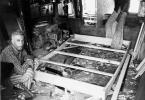 |  |  |
 |  |  |  |
After this illuminating lecture of practical physics, Hamid got the picture competely. I had calculated the curves that I wanted the frame to have, and, as you can see from the pictures above, he built me a point focus frame according to my specifications. My plan was to glue the mirror film to the wooden board, but this process did not work the way I had hoped. The accuracy did not turn out to be good enough in order to achieve the necessary optical quality. And unfortunately my reserve plan - the planar strips - did not work either, or rather, I did not get a chance to try it. I was simply unable to find a place in Srinagar where I could lay my hands on some mirror strips - or some large enough mirrors to cut up into strips for that matter. In retrospect, I should have anticipated this problem, but alas - as things turned out there was nothing I could do about it.
So the mirror frame remained just that - a frame. It represented an attempt that failed because of lack of appropriate material, which taught me an important lesson with regards to working in a remote location. Another important lesson was the one I was taught by the Indian security police, who turned up in the middle of my project and wanted to know what kind of device that we were building. It took some heavy persuation on my part - as well as another mirror burning demonstration - to convince them that it was not a spy antenna for the CIA.
KTH - Konstfack - Hannes Alfvén, fall 1979
I went back to Sweden in the beginning of September, and during the fall of 1979 our preparations for the Sun-or-Uranium exhibition continued. At the same time - as a preparation for the upcoming nuclear energy referendum that was to be held on March 20 the following year - there was a national energy education effort going on all over Sweden in the form of courses and study groups sponsored by the energy industry, the political parties and the labour unions. Since I had been somewhat exposed in the media as a kind of "solar energy prophet", I was invited to lecture on energy in a multitude of different places. Everybody seemed to be talking about energy, and many people were engaged in learning new things about this subtle and difficult concept.
Of course, some Swedish people had been talking about energy for several years. Most prominent among them was the Swedish physicist, KTH professor and Nobel laureate Hannes Alfvén. He had been involved in the attempts to develop a Swedish brand of deuterium-based nuclear reactor (Marviken), and following the failure of this immensely expensive project in 1973, he had "defected" and become an outspoken critic of nuclear power. Since we were both anti-nuclear activists, I managed to persuade Hannes Alfvén to give a popular talk on nuclear power at Konstfack, and on September 19 he delivered a brilliant and very engaging lecture. (Minnesanteckningar från föredrag på Konstfack 19 september 1979).
Meeting Hannes Alfvén gave me inspiration in many ways. He was kind enough to give me several of his papers and notes on energy (Kommentar till Framtidssekretariatets rapport Sol eller Uran 1978), (Energi, Exergi och Tepidologi), including his personal copy (full of critcal comments in the margin) of the 1500 page report "Energy" by the Swedish energy commission, published in 1977. He also made me realize the enormous problem with "energy-illiteracy" that our high-tech society is facing when he told me that he had met a frigheningly large number of politicians and "energy-burocrats" that were unable to make the fundamentally important distinction between the concepts of "energy" and "work". In fact, as he pointed out in his comments (Remissvar på Energikommissionens rapport 1977) to the report of the Swedish energy commission, even the commission itself seemed unwilling (or unable) to make this distinction, since it gave a limited and misleading definition of the concept of energy by declaring (on page 75) that (my translation to English) "within the field of mechanics, energy is defined as a measure of the ability to perform work". For the benefit of the Swedish reader, I quote directly from this passage of Hannes Alfvén's comments:
=====
I ett betänkande som är avsett att lägga grunden för svensk energipolitik förväntar man sig sig först och främst en klar definition av begreppet "energi". Inte förrän på sid 75 tar kommittén upp detta problem och skriver där att "energi definieras inom mekaniken som ett mått på förmågan att utföra ett arbete". Detta är möjligen en användbar definition inom ett så snävt område som mekaniken, men som var och en som kan elementär fysik vet är det otillåtet att behandla de av energikommissionen diskuterade problemen med denna utgångspunkt.
Energien är som bekant oförstörbar, men energikommissionen tycks behandla den som en vara som produceras och konsumeras. "Brist på energi" kan aldrig uppstå då värmeenergin i vår omgivning är enormt stor, men det är endast under vissa förutsättningar som denna kan utnyttjas (vilket bl.a. sker i värmepumpar). Vidare är det nödvändigt att skilja på högvärdig och lågvärdig energi. Att blanda ihop dem som kommissionen ofta gör är lika felaktigt som att räkna en kassabehållning genom att ange hur många slantar man har, utan att bry sig om ifall slantarna är femöringar eller enkronor. [...]
Frågan om energiens natur är icke en semantisk eller rent akademisk fråga utan av grundläggande betydelse för utformandet av en sakligt underbyggd energipolitik. Genom att energibegreppet aldrig klart definieras brister analysen därför i klarhet.
======
Solar Energy for Everyone - a basic course
Within the Sun-or-Uranium exhibition I was planning to do a solar energy workshop ("solenergiverkstan"), which would present the basics of solar energy (as well as the basics of the concept of energy in general) to a general audience. As a preparation for this I gave a course in solar geometry at KTH and Konstfack (Solgeometrikurs på KTH/Konstfack), which attracted about 15 students (although there were no course credits). This course represented an effort to present the basic concepts and ideas that are essential in order to understand how both local and global solar energy systems work. It also included a short story on the historical development of physics in general (Fysikens historia) and the concept of energy in particular (The birth of the principle of energy). An important text source for this course was the book Energikrisen - en bluff (The energy crisis - a hoax) by the Swedish physicist Gösta Walin. His list of "eleven propositions about energy" ('Elva teser om energi') were thoroughly discussed in my lectures. But most important with respect to the upcoming referendum was to try out pedagogical models that could explain the difference between energy and work in a way that was understandable to non-experts. Here the excellent articles Entropi - ordning och oordning, Exergi and Kaskadkoppling av industriella processer by Leif Andersson in the magazine Energiteknik served as a good starting point. The material that remains from what I gathered and produced for this course is presented (mostly in Swedish) at the website Solenergi för alla (Solar Energy for Everyone).
An important purpose of the solar geometry course were to start training a group of solar energy instructors that could help spread these ideas in a nation-wide energy exhibition tour that we planned to launch after the Sun-or-Uranium exhibition in Stockholm. The need for such a campain had become more and more obvious to me the more I was talking and lecturing on these subjects. Just like Hannes Alfvén, I had come across far too many politically influental persons that simply had no idea about the scientific fundamentals of the concept of energy. Even people that were involved in making decisions about our future energy systems!
The practical part of the course consisted of building a parabolic (single) cylindrical linefocus mirror (for distilling water) and a parabolic double cylindrical pointfocus mirror (for melting metal). They were to be used as a blueprints for constructions at the solar workshop of the Sun-or-Uranium exhibition. The construction took place at Konstfack. Unfortunately I have been unable to locate any pictures of the finished models, but a layout of the parts of the second mirror of the pointfocus is presented below.
 |  |  |
| Second frame laid out 1 | Second frame laid out 2 | Second frame with mirror |
The Sun-or-Uranium Exhibition at the Stockholm Culture Centre, February 1980
The idea of the Sun-or-Uranium exhibition was based on a report called Sol eller Uran - att välja energiframtid (Sun or Uranium - a choice of energy future) written by Måns Lönnroth, Thomas B. Johansson and Peter Steen and published as a report from the Swedish Secretariat for Futures Studies (Sekretariatet för Framtidsstudier) in 1978. The report painted two different scenarios for the future, called respectively Solar Sweden (Sol-Sverige) and Nuclear Sweden (Uran-Sverige). The basic idea of the exhibition was to try to illustrate the rather abstract language of the report in a way that made the options more clear and meaningful to the general public. A specific focus was to be placed on the creative and consumptive aspects of each technology (Sol-Uran - framtidsbilder). Moreover, in the words of Kerstin Abram-Nilsson from the preliminary application (Preliminär ansökan):
======
Utgångspunkten har varit ett resonemang om att dessa utredningar - hur angelägna de än är - så sällan är lockande att läsa för en bredare allmänhet, även om just denna utredning hör till de mest lättlästa och lättast förståeliga. De görs som bekant annars på en abstraktionsnivå som hidrar oss vanligt folk att ta dem till vårt hjärta. M.a.o. upplevelseaspekten är sällan tillräckligt tillgodosedd, varvid förbindelsen mellan hjärta och hjärna blockeras.
======
The preparation of the Sun-or-Uranium exhibition involved a large group of people, some of which I have unfortunately forgotten the names of during the quarter of a century that has passed since then. The group included Kerstin Abram-Nilsson, Jens Tydén, Sune Fogde, Nisse Stenquist, Örjan Wikström, Marianne Gille, Lars Hillersberg, Daniel Lindén, Charlotte Helin-Lindén, Hjördis Tegsell, Ambjörn Naeve, Lars Svensson, Mats Nordin, Björn Lind, Peter Steen, Ola Johansson, Lars Broman, Ann-Margret Dahlquist-Ljungberg, Eva Moberg, Anders Linder, Anna Roll, Monica & Carl-Axel Dominique. If you are a "missing participant" (or if you know of one) and you happen to come across this web page, please drop me an e-mail to let me know and I will add the corresponding name to the list above.
The driving force behind this effort was Kerstin Abram-Nilsson. During the spring of 1979 she wrote the preliminary application (Preliminär ansökan), where we aimed for an exhibition during the fall of 1980. However, when the "Harrisburg incident" occurred and it was decided to hold a referendum on the future of nuclear energy in Sweden on 20 March 1980, we decided to opt for an earlier date, knowing that this would be politically controversial. This is reflected in the application (Ansökan) as well as in the letter to Beate Sydhoff (Brev till Beate Sydhoff), who was head of the Stockholm Culture Centre at this time. In spite of the efforts to shut us down, she managed to convince the cultural board (Kulturnämnden) to give us a green light, which is reflected in the minutes from its two meetings on September 21 ('Kulturnämnden 21 september 1979') and October 8 ('Kulturnämnden 8 oktober 1979').
The initial plan for the solar energy workshop included a multitude of different projects (Solenergiverkstan). However, as time went by during the fall, this very ambitious scheme was considerably narrowed down and we concentrated on the the single and double cylindrical parabolic pointfocus mirrors, for which we were already producing the blueprints during my solar geometry course.
In the beginning of October, we produced a "letter of request" for contributions The Sun or Uranium Exhibition (Utställningen Sol eller Uran) that was widely circulated and which brought in responses and relevant material from several different sources. The structure of the exhibition was starting to take form, and we produced the first sketch of the floor plan (Utställningsplan). It was a hectic time and many of us were working more or less around the clock.
However, all this heavy working took its toll on my health, and a few days before the exhibition was to open I "hit the wall", fainted from fatigue and woke up in a hospital. My body had simply overruled my work-schedule, and although my mind was full of energy, my body was totally drained of it. This meant that the solar energy workshop had to be restructured. Marianne Gille did a marvelous job on saving the situation and turned the solar energy workshop into a UFO space creativity workshop for kids that turned out to be a great success.
The Sun-or-Uranium exhibition ran between February 1 and March 22 and had many visitors. Although it was critized by the nuclear establishment for being "solar biased" - which, in retrospect, I must admit was true - it was well received by the general public. It bears witness of my weakness at the time that I never took any pictures from the actual exhibition - not even of the large mural paintings of Solar-Sweden and Nuclear-Sweden that were its main attractions. If any one of you out there have any pictures from the exhibition, please send them to me and I will include them here.
///////// PLACE FOR MISSING PICTURES!!!
The nuclear energy referendum
Although we were admittedly solar biased, we were not able to turn the energy referendum into a clear "no" to a nuclear energy future. Instead, on March 20 the Swedish people (in an extremely close call) voted for "closing down nuclear power in a sensible way" ("avveckla kärnkraften med förnuft"). This was the message of the famous "second alternative" (linje 2), led by Rune Molin and Hans Blix, who a few years later was appointed head of the International Atomic Energy Association (IAEA). I guess the victory in the Swedish nuclear energy referendum was an important addition to his qualifications for this job. Because six years later he could be seen in a helicopter circling over Tjernobyl trying to show that a nuclear meltdown could be handled in a sensible way.
The "sensible close down" of nuclear power in Sweden was started by doubling the number of operational nuclear reactors from 6 to 12. In order to get rid of all the extra electricity produced, home owners were encouraged to install electrical heating in their houses by receiving heavy subsidies from the state if they did so. Now, one of the little known facts about energy is that electrical energy has about ten times more work power in comparison with heat energy of 20 (centigrade) degrees higher temperature than its surroundings, which is the desired end-product when you are heating a house. Hence, heating with electricity means throwing away about 90 percent of its work power. It is analogous to building a ten story house, and using it to move from the ground to the top floor and then move down again 9 floors, when all you really want to do is to end up on the first floor.
In the light of this development, the words of Hannes Alfvén (cited above) appear spookily prophetic. There could not have been a more clear illustration than the "sensible close down" of nuclear power in Sweden during the 1980s of the devastating effects of the inablilty (or even worse: the unwillingness) of the people in power to discriminate between the concepts of energy and work.
Solar collector course at Lindsberg, July 1980
It took me a few months to recuperate from my "energy collapse" and during the spring of 1980 I did little else but taking it easy. Also, the disappointment of loosing the referendum in such a close way decreased the energy of the Swedish alternative energy movement.
However, some enthusiasts were still active. Among them Lars Broman, physics teacher at Falun/Borlänge university college and one of the most prominent solar energy activists in Sweden. Lars Broman was arranging a one week course on the theory and practice of solar collectors, and he had the kindness to invite me to serve as a co-instructor with him on this course (Inbjudan till solfångarkurs på Lindsberg).
 |  |  |  |
| Ambjörn and Lars | Ambjörn's pointfocus | Assembling | Fine tuning |
We spent a week in July (14-19) at Lindsberg outside of Falun, building a simple but effective solar collector for heating water. As part of the general theory of solar collectors, I also demonstrated the double-cylindrical point focus prototype that we had built during my solar geometry course last fall. The course was quite successful, and it was a good experience to meet people that had a practical interest in contributing to a better energy future.
However, the victory of the "sensible close-down" alternative in the nuclear referendum was taking its toll with the general public. This is reflected in how the course was reported in the local newspaper Dalademokraten: En snål vind möter alltjämt solfångaridén ("A chilling wind still meets the idea of solar collectors").
Back to mathematics - discovering the beauty of nineteenth century geometry
In the fall of 1980, I resumed my graduate studies in mathematics, which I had suspended when I started traveling back in 1974. I went into an intense period of studying mathematics - especially geometry, and discovered such old geometry masters as e.g. Felix Klein, Sophus Lie, Gaston Darboux and Luther Eisenhart. They would become prominent among the "dead poets" whose company would keep me occupied for the next 15 years.
This shift of focus of course meant that my solar energy activites were shifted out of focus for a while. However, whenever someone asked me, I would give a talk or hold a seminar - most often on some aspect of "eco-logical technology" connected to solar energy or holography. A good example from this time is provided by a seminar I gave in Gothenburg in March 1981, and which was described in Göteborgsposten under the heading Local Technology is our only chance for survival (Lokal teknik är vår enda chans om vi ska överleva). Since this article roughly sums up my position at the time on the energy issuses, I have included the text here for the convenience of the Swedish reader.
////////// Göteborgsposten, mars 1981:
LOKAL TEKNIK ÄR VÅR ENDA CHANS OM VI SKA ÖVERLEVA
"Att använda lokal teknik är enda möjlighteten till överlevnad på jorden. Vårt nuvarande ekonomiska system bygger på småskalig information och storskalig produktion. Alternativet är storskalig information som möjliggör småskalig produktion. Baspelaren för ett annat slags samhälle är solenergin och konsten att utnyttja den i olika former."
Det hävdar Ambjörn Naeve, 33 årig civilingenjör och forskare i matematik, fysik och solenergi. Lördag-söndag leder han ett seminarium i Göteborg på temat Ekologisk teknologi - ett kreativt alternativ till det ekonomiska samhället. Det har ordnats av Konsthantverkshuset i samarbete med Kursverksamheten.
Naeve är lärare på KTH i Stockholm vissa tider och däremellan föreläsare och resenär. Han samarbetar med forskare i bl.a. USA och har också anknytning till Indien. Han arbetar helt självständigt och enbart med direkt information, till nuvarande utbildningssystem har han liten tilltro. Med FN "eller andra maktstrukturer" har han inte sökt kontakt.
Tumörstruktur
"Endast en del av människans kunskap är användbar i det ekonomiska systemet", säger Ambjörn Naeve. "Blodomloppet där är pengar, och eftersom allt i systemet kan mätas i pengar är detta det totala jämställdhetsbegreppet. Det finns en tumörstruktur i det ekonomiska systemet som ständigt ropar på tillväxt, tillväxt, tillväxt - ett fruktansvärt farligt ord."
Att få ut kunskap om småskalig lokal teknik är hans mål, och han vill skapa ett bildbaserat (och därmed lättbegripligt) ekologiskt språk riktat mot tredje världen. Drömmen är ett ambulerande universitet.
Punktfokusmaskin
Ett konkret exempel visar Naeve på seminariet. Tillsammans med USA-fysikern Lloyd Cross, en av utvecklarna av lasertekniken, har han konstruerat en punktfokusmaskin som hittills bara finns i prototyp.
Inget patent har sökts, meningen är att den som har behov av maskinen skall kunna bygga den med enkla hjälpmedel på sin hemort.
Med två konkava speglar fångar och koncentrerar maskinen solenergi till en punkt så att den kan användas för t.ex. materialbearbetning, som kraftverktyg, som smältverk, till att driva motorer och t.ex. pumpa upp vatten.
"Trots att jag hållit på i två och ett halvt år med detta i Sverige har ingen gjort något försök att använda maskinen", säger Ambjörn Naeve. "Det är signifikativt för hur fast vi sitter i vårt ekonomiska system".
/KET
//////////////////
Ladakh 1983
In the fall of 1983 I met Helena Norberg-Hodge, sometimes called "the lady of Ladakh", who has been working with ecological technology in Ladakh since she first visited this region when it was opened up to tourism in 1975. This work has centered around the creation of the Ladakh Ecological Development Group (LEDEG) and has involved the introduction of simple solar heating techniques in traditional Ladakhi houses. Helena was in Stockholm on a lecture tour, and as a reaction to her talks and presentations of the conditions in Ladakh, the support organization "Friends of Ladakh" (Ladakhs vänner) was formed. The first chairman was Pia Grönholm-Gillsäter, who later spent some time in Ladakh and together with Anna Kärnestam wrote the following report and evaluation of the work carried out within LEDEG (Solenergiarbete i Himalaya - En rapport och utvärdering av Ladakh Ecological Development Group's Solenergiarbete i Ladakh, Indien, 1984-86).
In 1986 Helena Norberg-Hodge was one of the recipients of the Right Livelihood Award, and in later years she has founded ISEC (International Society for Ecology & Culture). A more recent perspective on Helena's work can be found e.g. in her interview with David Leser from the May 27, 2000 issue of the Good Weekend.
The Solar Steel Plant - Sven Eketorp, KTH 1984
In january 1984 there was an "appropriate" technology hearing at KTH, with a focus on appropriate technology for developing countries. I gave a short presentation of the possibilities inherent in the double cylindrical pointfocusing mirrors, and a few days later, I received the following note (Brev om speglar) from Sven Eketorp, professor of metallurgy at KTH, where he notes his interest in the double cylindrical pointfocus, and two months later, I received the following letter from him (Brev om stålverk).
Sven Eketorp is an international authority on iron and steel production, and he has developed special techniques for such production at a very small scale (The village steel-works - concept for a small-scale steel production unit for local development). He has also pointed out the energy efficiency of scrap iron based iron and steel production in comparison to traditional production based on iron ore (Energi i järn- och ståltillverkning, Energiteknik nr 4, 1978). In his letter Sven proposed that we should join forces to build the smallest steel plant in the world - a solar powered steel plant, producing high quality iron (from scrap iron) at a smaller scale - and to a smaller investment cost - than ever before. I cite from the text of his letter (in Swedish and English):
//////////////// Brev om stålverk från Sven Eketorp, skrivet i mars 1984:
Som du ser av bifogade papper (Framtiden i våra händers Gambiaprojekt, Solspisen, Köks- och spisbyggen i Gambia 1989) arbetar min hustru på ett praktiskt plan i Gambia. Hon anser att målen primärt inte är pengar eller teknik, utan
- att nå de fattigaste,
- att allt ska vara hjälp till självhjälp,
- att engagera så många svenskar som möjligt (för att sprida andan).
Som metallurg skulle det naturligtvis roa mej att införa en ny stålframställningsteknik, det har vi jämt talat om. Om vi utgår från skrot, finns det ingen anledning att ha en smältvolym på 50, 10, eller ens 1 ton. Vi behöver inte mer än 50 kilo, och då kan vi också komma ner i effekt. Vi behöver (med rätt stora strålningsförluster) c:a 750 kWh/ton.
Vi behöver bara ha så mycket metall smält att vi kontinuerligt kan hålla en smält stråle vid liv, kanske 50 kg/tim, alltså 37.5 kW, säg 50 kW. Vad innebär det i spegelyta? Vi måste komma fram till något enkelt. Jag är beredd att jobba tillsammans med en engelsman på KTH's metallurgi, och Dig, och sedan söka pengar hos SIDA. Vi måste också tigga utrustning för sönderkapning av skrot från stålindustrin i Sverige.
Kan vi på detta sätt göra världens minsta stålverk till världens lägsta investeringskostnad? Let us try!
////////////////
Here is an English translation:
//////////////// Letter about a steel plant from Sven Eketorp, written in March 1984:
As you can see from the attached papers (Framtiden i våra händers Gambiaprojekt, Solspisen, Köks- och spisbyggen i Gambia 1989) my wife is working on a practical level in Gambia. She thinks that the goals should not primarily be about money or technology, but instead
1) to reach the poorest. 2) to turn all forms of help into self-help. 3) to involve as many swedes as possible (in order to spread the engagement).
As a metallurgist it would of course amuse me to introduce a new technique for steel production, something that we have always been talking about. If we start from scrap iron, then there is no need for a melting volume of 50, 10 or even 1 ton. In fact, we do not need more than 50 kilos, and therefore we can reduce the necessary operational power. We need (including rather large radiation losses) about 750 kWh/ton.
We only need to secure as much melted metal as is needed in order to maintain a continous spray-stream of melted iron, maybe 50 kg/hour, which means 37.5 kW, lets say 50 kW. What does that mean in terms of necessary surface area for the mirrors? We must get down to something simple. I am prepared to work together with you and an english guy at Metallurgy/KTH and apply for funding from SIDA. We must also "beg" the swedish steel industry to supply us with equipment for cutting up scrap iron.
Can we in this way create the world's smallest steel plant - for the world's smallest investment cost? Let us try!
////////////////
The following pictures illustrate what such a solar powered steel plant could look like. The fist two pictures are photos of a model of the pointfocus mirror for the plant made by Tomas Elofsson, whose work will be described below.
 |  |  |  |
| Solar steel works 1 | Solar steel works 2 | Steel works 1 | Steel works 2 |
 |  |
| Steel works 3 | Steel works 4 |
The SIDA alternative energy hearing at Ladvik, May 1984
I was very happy about Sven Eketorps offer to collaborate on designing a solar steel plant, and we started a set of activites aimed at getting the Swedish aid organization SIDA to fund our work. Our special target was the alternative energy division at SIDA, led by Karin Wohlin. When I called here up in the beginning of May, she told me that her group was about to host a 2 day hearing on small scale energy production at Ladvik in mid-May (I think it was May 12-13), and she invited me to come to Ladvik to present the ideas behind the project.
So, about a week later, I went to Ladvik and gave a presentation, which - thanks to to the clear skies - included a practical demonstration of melting metal with solar power. (Unfortunately there were no pictures taken of this event). Of course, my presentation did not only cover the ideas for the solar steel plant, but gave a general overview of the many possibilities inherent in making use of the double cylindrical pointfocus in small scale energy applications for developing countries.
But, unfortunately, these ideas were not "favorably received". I suspect that (from the side of the participating groups and organizations) there was a lot of lobbying for financial support from SIDA going on behind the scenes, and it seems to me like our ideas were experienced as a threat to these interests. This is the only way that I can explain the behaviour of e.g. Varis Bokalders, who was chairing the session of my presentation, and who gave me an introduction that in fact ridiculed the entire idea of the double cylindrical pointfocus as being totally useless. It was a sad but enlightning experience to see a member of the Swedish "solar energy power structure" turn around completely on ideas that he had earlier supported and deny their value in public. It is often said that "money talks", but in this case I think it was the fear of missing out on funding that talked!
Now, if it had been five years earlier, this minor setback would not have affected my willingness to go on with the project. But times had changed and I was now heavily involved in my graduate mathematics studies. Moreover, my six years of promoting the solar mirrors in Sweden (1978-1984) without any real response had taken its toll on my enthusiasm, and the failure at Ladvik led to a suspension of our solar steel plant project. In retrospect, this was very unfortunate, since I think we would have had a chance to really get this project going, but in the midst of all our other activites, neither Sven Eketorp or I had the energy (or the time) to properly prepare for it. And, most importantly, we did not succeed in finding the bureaucrat at SIDA whose personal career would have benefitted from starting up such a project, and who therefore would have been willing to make it her or his own. Without this kind of internal organizational commitment, it is very hard to get a project like this off the ground.
Tomas Elofsson, Gusum 1985 - 2004
In the spring of 1985 I received a phone call from Johnny Nemeth in Valdemarsvik, who invited me to give a talk on solar energy at the local high-school there. After the talk, Johnny came up to me and said: "You must meet a guy called Tomas Elofsson who lives in Gusum (near Valdemarsvik). You two have a lot in common, and he will be very interested in your ideas".
Tomas Elofsson, who sadly and unexpectedly died in February 2004, was a metalworker at Boliden and a well-known person in Gusum, where he was living at the time. He was a multi-talented person and he was engaged in a variety of different activities, including the leadership of a theatre group called "Brothers and Sisters" in Gusum. Two months later I went back to Valdemarsvik and gave a solar energy lecture for Tomas and a group of teenagers that he was working with in a special youth project. The lecture took place on an old dampship that Tomas and his crew were renovating and turning into a sort of resource and activity centre for unemployed youth.
The lecture was a real success, and I will never forget the enthusiasm that Tomas displayed when he was introduced to the double cylindrical pointfocus principle. Here at last, after nine years, was a person that I felt was prepared to invest his own energy in contributing to developing these ideas further.
And contribute he did. About two years later, in June 1987, I got a letter from Tomas (TO BE SCANNED), with the following drawings and photos attached. They show the double cylindrical point focus mirror that he had just constructed, as well as his youngest daughter Amanda (at age 3) beside the mirror.
//////////// Drawing of Trehjuligen-87
 |  |
| Amanda and the pointfocus mirror | Tomas' first pointfocus mirror |
From this point on, Tomas was pouring his creative energy into the development of the pointfocus mirrors. He came up with drawings of more or less every application of the pointfocus that Lloyd and I had discussed a decade earlier, plus several application ideas of his own that he communicated to me in the form of drawings. The simple steam engine design is a good example, which Tomas created out of inspiration with the possibilities inherent in the pointfocus. He later realized that it would not work so well, but the lessons he learned from trying out such exercises were invaluable for gaining improved insight into the underlying problems and principles.
One of the pointfocus constructions that we were discussing was as a "solar trailor" that could be drawn by a horse as well as by a car, and, as usual, Tomas came up with drawings. He also created a comic strip with a "pedagogical agent" that could explain the underlying physics in a "visually dramatized" way. It was great! At last I had managed to infect someone else with the "idea-virus" of the pointfocus. And not just anybody, but a creative visonary person who could express his ideas fluently both in the form of drawings and metal work.
Pointfocus comic strip
Elofsson, T., Introduktion till seriefigur
 |  |  |  |
| Seriefigur intro 1 | Seriefigur intro 2 | Seriefigur intro 3 | Seriefigur intro 4 |
Elofsson, T., PunktFokus - serie (PDF)
 |  |  |  |
| PunktFokus 1 | PunktFokus 2 | PunktFokus 3 | PunktFokus 4 |
 |  |  |  |
| PunktFokus 5. | PunktFokus 6 | PunktFokus 7 | PunktFokus 8 |
Construction for mirror strips
 |  |  |  |
| Brev till Ambjorn | Spegelstrips 1 | Spegelstrips 2 | Spegelstrips 3 |
 |  |  |  |
| Spegelstrips 4 | Spegelstrips 5 | Spegelstrips 6 | Spegelstrips 7 |
Solar powered steam engine
 |  |  |  |
 |  |
Sketches
 |  |
| Stor spegel skiss | Häst solkrafter 1 |
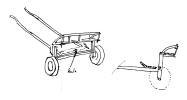 |
| Häst solkrafter 2 |
 |  |  |
| Släpkärran skiss 87 | Grop variant 1 | Grop variant 2 |
 |  |  |  |
| Marin variant 1 | Marin variant 2 | Nedsänkt variant | Sol stålverk 1 |
 | 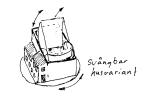 |  |
| Sol stålverk 2 | Svängbar husvariant | Trehjulingen skiss 87 |
 |  |
| Spegel fokusering | Spegelplex sågbord |
The Futura trust fund (Stiftelsen Futura) 1987
Tomas' arrival on the scene with all his creative energy and enthusiasm raised the energy level of the project by an order of magnitude. Around this time a friend of mine, Robert Holmin, told me that the trust fund Futura, which he was involved with, were supporting this kind of research and that it would be a good idea for us to apply for funding from them. So by the end of September, I turned in the follwing application to the Futura trust fund (in Swedish):
/////////// (Sumary in English below):
Till: Från: Ärende: Stiftelsen Futura Ambjörn Naeve Ansökan om medel c/o Helmer Perssons Skånegatan 87 för vidareutveckling Advokatbyrå AB 116 37 Stockholm av solenergiprojekt Kungsgatan 17 111 43 Stockholm
Projektbeskrivning
Mitt namn är Ambjörn Naeve. Jag är född 1947, tog studentexamen 1966 och civ-ing-examen 1972 på KTH (teknisk fysik). Sedan 1967 har jag varit verksam som lärare i matematik vid KTHs matematiska institution med undantag för åren 1974-1978 då jag för det mesta befann mig på resande fot i bl.a. Afrika, Indien och Amerika.
För snart 11 år sedan (nov 1976) upptäckte jag tillsammans med min vän Lloyd Cross i San Francisco ett nytt sätt att koncentrera strålningsenergi "en dimension i taget" - den s.k. "dubbelcylindriska punktfokusprincipen" (bilaga 1 och 2). Efter en hel del funderingar valde vi att inte ta patent på vår upptäckt utan att i stället satsa på att försöka göra den tillgänglig för så många som möjligt. Detta var inget enkelt beslut att fatta eftersom vi insåg att spridningen av vår idé skulle komma att väsentligt försvåras av det faktum att inget "etablerat" företag med de resurser som krävs för produktutveckling skulle våga satsa på en idé som det inte kunde garanteras att få ensamrätt på. Samtidigt ville vi inte betrakta vår "princip" som embryot till en produkt i traditionell mening, utan mera som ett stycke användbar information. Det är nämligen enkelheten i vår energikoncentrationsprocess som är dess verkliga styrka, eftersom den gör det möjligt att lära ut tekniken (dvs tillverkning och underhåll av maskinen) till en mycket stor publik.
Jag byggde till exempel år 1979 en enkel "energiskottkärra" tillsammans med en bysnickare i Kashmir (se bilder på bilaga 3). Han var analfabet (men mycket intelligent!) och vi började projektet genom att ta varsin av de två böjliga plastspeglar som jag hade med mig, rikta dem mot solen enligt mina instruktioner och tillsammans sätta eld på en av hans skor! Sedan förstod han precis vad det hela gick ut på! Så småningom lärde han sig även att förstå var de "kritiska parametrarna" i processen fanns någonstans - mycket tack vare det bildmaterial som jag hade utvecklat för att beskriva den.
Genom mina studier av naturvetenskap och mina resor runt om i världen har jag blivit övertygad om att "det finns tillräckligt för alla" på vår planet, OM vi bara kan lära oss att utnyttja naturprocesserna på ett tillräckligt intelligent sätt! Kunskap är nyckelordet! För att kunna överleva på längre sikt måste vi lösa ett gigantiskt utbildningsproblem: Vi måste utöka den "matematiskt exakta" formelbeskrivningen av naturprocesserna (som vi behärskar så väl!) med ett "naturfilosofiskt bildspråk" som fångar upp det mest väsentliga och uttrycker detta "så att det kan förstås av de flesta" med hjälp av alla möjliga metaforer, analogier och liknelser. Här kan "högteknologiska" hjälpmedel som t.ex. datorgrafik och animerad film lämna ett värdefullt bidrag!
Alltsedan upptäckten av den dubbelcylindriska punktfokusprincipen har jag arbetat på att utveckla ett sådant bildspråk. Kursen "solenergi för alla" (se bilaga 4) är ett steg i denna riktning och finns dokumenterad i ett material som tyvärr är alltför omfattande för att kunna skickas med i den här ansökan. Denna kurs har testats på "teknologiska analfabeter" med gott resultat bl.a. i samband med en "informations-konst-show" (information-art-show, bilaga 4) kallad "The Naive Mathematical Planetarium" i Davies, California 1978 samt i Falun under miljöförbundets "solfångarkurs för nybörjare" sommaren 1980.
Mitt arbete med att visualisera naturprocesser har fört mig långt in i geometrins och datorernas världar där jag för närvarande är verksam. Samtidigt har jag ända sedan min återkomst till Sverige 1980 försökt att få kontakt med människor som har intresse och kunskaper för att arbeta med vidareutveckling av energiskottkärran. Jag har hållit uppåt hundra föredrag, presenterat den i alla möjliga sammanhang och ständigt betonat att: det finns inga patent - idén är tillgänglig för alla. Jag är beredd att samarbeta med vem som helst som är tillräckligt intresserad för att satsa sig själv och som delar min uppfattning om syftet: att utveckla en "informationsteknologisk process" som gör det möjligt att sprida kunskapen om hur man bygger och underhåller en teknologi baserad på energiskottkärran till så många som möjligt".
Gensvaret har emellertid varit litet - ja egentligen obefintligt - till för två år sedan. Då fick jag (genom ett av mina föredrag) kontakt med en metallhantverkare i Gusum vid namn Tomas Elofsson. Han "tände" både på "skottkärrans teknologi" som idé och på möjligheten att sprida kunskap om hur man tillverkar den.
Tomas har en liten metallverkstad och där har han under de sista två åren på sin fritid vidareutvecklat Lloyds och mina designideér och byggt en dubbelspegel på 120 cm x 80 cm (den största spegelns mått) med effektiva men enkla och lättmanövrerade inställningskontroller (se bilaga 5, fig 1). Den är så färsk att vi inte har hunnit testa den ordentligt i klart solljus ännu - sommaren har ju inte precis varit hjälpsam med klara soldagar! - men vi räknar med att åtminstone kunna smälta järn (c:a 1500 grader Celsius) med den. För nio år sedan i San Francisco byggde Lloyd och jag en lika stor dubbelspegel (som dock helt saknade mekanisk inställningskontroll) och med den lyckades vi så småningom smälta sand (c:a 1750 grader Celsius) - efter mycket besvär med den helt manuella inställningen av krökningen hos speglarna!
Man får dock räkna med att en viss försämring av "solkonstanten" - dvs den tillgängliga effekten per ytenhet - har ägt rum under det senaste decenniet på grund av alla olika utsläpp i atmosfären. Tumregeln är att man får ungefär 700 W/m2 som instrålning mot en yta vinkelrätt mot solljusets riktning en klar soldag. Det ska bli mycket spännande att få testa den nya dubbelspegeln och se vad den "går för"! Både Lloyd, Tomas och jag själv är mycket entusiastiska över Tomas förbättringar och vi vill gärna gå vidare med projektet. Lloyd är en genial uppfinnare och konstruktör och Tomas är en extremt skicklig praktiker med väl utvecklad känsla för olika material och som dessutom tecknar bra (han har gjort alla skisserna i bilaga 5).
Vi har hittills arbetat helt ideellt - dvs obetalt på fritiden - och bekostat allt material själva. En meningsfull vidareutveckling av projektet kräver dock en insats av både material, lokaler och arbete som gör det omöjligt att fortsätta på detta sätt. Det naturliga steget härnäst är byggandet av en dubbelspegel på 360 cm x 240 cm (bilaga 5, fig 2) där den största spegeln är uppbyggd av tre "moduler" på 120 cm x 240 cm, utförda enligt samma "ramkonstruktion" som Tomas redan har tagit fram (bilaga 5, fig 3). Detta kräver dock en annorlunda teknik för inställning av speglarna där varje modul ställs in (dvs fokuseras) var för sig, helt fristående från de övriga.
Både Tomas och Lloyd har vissa ideér om hur detta kan göras effektivt, men det är svårt att förutsäga exakt hur mycket utvecklingsarbete som krävs för att få det hela att fungera - vi har uppskattat det till c:a 3 månader på heltid. Med en lönekostnad på 70 kr/tim (50 kr + 40% LKP) och en arbetstid på 160 tim/mån (8 tim/dag, 5 dag/vecka, 4 veckor/mån) leder detta till en arbetskostnad på 33.600 kr. Eftersom Tomas endast har möjlighet att arbeta med detta på halvtid medför det en tidsåtgång på c:a 6 månader. Under denna tid måste vi hyra en lokal som är tillräckligt stor och vettigt utrustad. Vi kan räkna med en kostnad på drygt 3000 kr/mån för en sådan lokal i Valdemarsvik - dvs totalt 20.000 kr. Speglarna (s.k. "spegelplex") består av acrylplast med ett vaccumbelagt skikt av aluminium på baksidan. De kostar c:a 4000 kr/styck och vi behöver totalt 5 stycken, vilket ger en "spegelkostnad" på 20.000 kr. Övrigt byggnadsmateriel (metalldelar för ramverk, inställningsanordningar mm.) kan uppskattas till ungefär 10.000 kr. En viktig del av projektet är dokumentation, bl.a. framställning av en uppsättning maskinritningar av alla ingående delar. Detta arbete måste utföras av en "fackman" enligt gängse taxa. Vi uppskattar de totala dokumentationskostnaderna till c.a 10.000 kr Slutligen bör vi räkna med "diversekostnader" på 5000 kr som en liten buffert mot oförutsedda utgifter.
Detta leder sammanfattningsvis till följande kostnadstablå för projektet:
Kostnadsslag Kronor
Lönearbete 35.000
Byggnadsmateriel 30.000
Lokalhyra 20.000
Dokumentation 10.000
Diverse 5.000
=====================
Totalkostnad: 100.000
Framtida utvecklingsmöjligheter
Den dubbelspegel som är kostnadsberäknad ovan kommer att ge en effekt på c:a 3 kilowatt i klart solljus. Detta är fullt tillräckligt för många tillämpningar men även ett viktigt steg på väg mot de dubbelspeglar som avbildas i bilaga 5, fig 4. Det är i denna storleksordning som den dubbelcylindriska punktfokusprincipen kommer att visa sin verkliga styrka - som bas för en småskalig solkraftsteknik för såväl metallbearbetning som kraft- och elektricitetsalstring. Till slut kan jag nämna att professor Sven Eketorp vid institutionen för tillämpad processmetallurgi på KTH har konstruerat ett "ministålverk" som arbetar med återanvändning av järnskrot (se bilaga 6). Han är mycket intresserad av våra speglar eftersom han räknar med att en dubbelspegel med 34 m2 ingångsyta (bilaga 5, fig 4) bör ge tillräcklig effekt (c:a 12 kW) för att kunna driva hans anläggning.
KTH 29/9 1987
Ambjörn Naeve
///////////
In summary, the application was aimed at building a large pointfocus mirror (360 cm x 240 cm) and mounting it on the frame of an old camping trailor that Tomas had managed to secure. When operating, this "solar trailor" would give us about 3 kW of highly concentrated solar power. It was supposed to be used for demonstration purposes, and it would give us a basis to start experimenting with absorbers that could be effective in melting scrap iron for the solar steel plant.
Over the next 18 months, the Futura trust fund gave us the 100.000 kr we applied for, but divided it up in two portions of 50.000 kr each. The details of the interaction with the Futura trust fund are documented in (Dokumentation av ansökningsprocessen till Futura).
Tomas Elofsson's dissemination work
The support from Futura a it possible for us to start the development of the solar trailor. Also, I had started making some money as a "problem solving" consultant for industry, money that came in handy for our solar development. Apart from the solar trailor, we were also working on an improved version of a smaller pointfocus, the solar tri-wheel (energitrehjulingen), as well as on a construction that would be based on plane mirror strips.
Tomas' work was creating local attention, and he was asked to write about his solar projects in LO-tidningen (the paper of his union). The result was the article Mångsysslande Metallare i Gusum, LO-tidningen Metalltolvan, nr 1, 1989. He was also interviewed by other papers, e.g. by Norrköpings Tidning:
///////////// Yman, B., Plexiglasspeglar ska lösa u-ländernas energiproblem, Norrköpings Tidning, ⚠ 1988-12-28.
Speglar som de som används i lustiga huset ska kunna lösa energiproblemen i tredje världen. Det är i alla fall tanken med ett projekt med speciella solfångare som forskare på Kungliga Tekniska Högskolan i Stockholm håller på med och som har hjälp av gusumsbon Tomas Elofsson i en experimentverkstad.
Det började 1985 för Tomas Elofssons del när han hörde en forskare från KTH, Ambjörn Naeve, berätta om hur man kan utnyttja solstrålarnas arbetsförmåga genom att via speglar koncentrera solens strålar till en brännpunkt, ett punktfokus. Det är nu arbetsnamnet på den konstruktion som ska utvecklas och som är ämnad först och främst för tredje världens energibehov, som t.ex. att driva ångmaskiner, smälta stål etc. Men också för att utveckla strålkastare m.m. ja listan kan göras lång när den entusiastiska gusumbon Tomas Elofsson berättar.
Inga patent
I realiteten började idén redan 1976 i USA när Ambjörn Naeve forskade tillsammans med en amerikan. De kom på att man kunde använda fyrkantiga (plana) speglar, böja dem konkava och därigenom fånga upp solstrålar som sedan fick reflekteras i de båda speglarna för att sedan återkastas till en smällhet punkt. Denna brännpunkt kan bli så het att den kan smälta stål, allt beror på spegelns storlek och solens intensitet.
De två forskarna var politiskt medvetna och sökte inte patent på sin idé utan åkte runt och föreläste om den. Men den fick ingen spridning och behövde vidareutvecklas. Nu är den utvecklingen på gång.
Experiment
Tomas Elofsson har tagit tjänstledigt ett år från sitt arbete på verktygsavdelningen vid Boliden-Bergsöe för att bygga upp en experimentverkstad åt Ambjörn Naeve och utveckla punktfokuskonstruktionen. Den har inte testats mer än i liten skala, men för att bli effektiv måste den testas med större speglar, t.ex. för att se hur stora plexiglasskivor som kan böjas och ändå ge önskad effekt. Tomas Elofsson räknar med att en kvadratmeters skiva ger knappa en kilowatt effekt. Men nu ska Tomas först göra en "energikärra" klar. Det är en släpvagn där han placerar en punktfokuskonstruktion och sedan ska den fara land och rike runt för att visas upp. "Det är nämligen svårt att få folk att förstå hur enkel och genial idén är", menar Tomas. "Arbetskamrater som skrattat åt mig har blivit mycket förvånade när jag visat dem hur solfångaren kan sätta eld på en träbit på ett kick".
Lustiga hus-speglar
Spegelglasen som används är desamma som lustiga husen använder för att böja till olika kupigheter. Fördelen med plexiglas är just att det är böjbart och det finns i dag i byggstorlek, dvs 120 cm x 240 cm. De ska som solfångare kunna byggas ihop till större enheter för att få ut ännu mer energi. Men det är sådant som ska prövas under Tomas tjänstledighet.
KTH har också ett samarbete med tekniska högskolan i Nicaragua. Till det projektet ska Tomas sätta in en lampa i solens ställe så att forskarna kan mäta på de utgående strålarna hur mycket energi som speglarna slukar, dvs se hur effektiva spegelytorna är.
Meningen är att inte bara tredje världen ska få glädje av punktfokuskonstruktionen, utan att projektet också ska se hur strålkastare m.fl. saker kan utnyttja tekniken. Tomas är tveksam till att ett tjänstledigt år ska räcka, men det är vad han har nu. Det kan innebära en hel del resande för honom förutom arbetet vid ritbord och med praktisk konstruktion. Nu har också Sida fått upp ögonen för projektet och vem vet vad det kan föra med sig.
/ Britt Yman
/////////////
Tomas Elofsson's correspondence with the Swedish ministery of energy
In october 1989, Tomas Elofsson wrote the following letter to the Swedish minister of energy, Birgitta Dahl.
///////// Elofsson, T., Till Energiminister Birgitta Dahl
Gusum 89 10 15
Till energiminister Birgitta Dahl
Hej
Jag heter Tomas Elofsson, är metallarbetere i Gusum och arbetar f.n. på Boliden Bergsöe (f.d. Gusums Bruk). Sedan 1985 har jag på min fritid arbetat med att utveckla en typ av solfångare som fokuserar ljuset till en fokalpunkt. Denna fokalpunkt ger mycket höga temperaturer, vid klart solsken över 300 grader.
Upptäckten av "Punktfokus" som idén kallas, gjordes i San Francisco år 1976 av Ambjörn Naeve och Lloyd Cross. Bäst förklaras "Punktfokus" i Ambjörn Naeves egen skrift med samma namn (se bil. 1). Ambjörn Naeve är civilingenjör och matematiker och arbetar som lärare på KTH i Stockholm. Det är med honom jag samarbetar.
Det hela började i Valdemarsvik 1985, när jag hörde ett föredrag av Ambjörn om "Punktfokus". Jag blev genast intresserad och började experimentera och bygga solfångare. 1988 blev den första klar (se bil. 2). Första halvåret 1989 har jag varit tjänstledig från mitt ordinarie arbete för att arbeta med solfångare. Jag har byggt tre solfångare som KTH beställt av mig. De ska användas till test och utvärdering (se bil. 3).
En större solfångare är under byggnad. Den ska stå på en släpkärra för att kunna dras bakom en bil till olika platser för demonstration. Tyvärr står den halvfärdig pga penningbrist (se bilaga 4).
I en av de solfångare som KTH köpt (den koncentrerar 1,5 m2 av solljuset) har jag smält bl.a. koppar och glas, båda med en smältpunkt på över 1000 grader. Det är inte dåligt för en så liten solfångare. I all synnerhet som intrimningen av speglarna inte var den bästa vid detta tillfälle. Om 1,5 m2 kan ge en sådan värme, vilken effekt och värme kommer då inte en solfångare på 10 m2 eller kanske 100 m2 att ge???
SOLENERGI. Vad är det? Det är många som drar på munnen och säger att på natten och på vintern, då ger inte solen någon energi. Inte heller om det är mulet eller regnar. Visst. Det låter riktigt och sant, och det är sådana villfarelser vi går på. Men titta på följande exempel. En kall vinterdag står termometern på -23 grader C. Solen värmer då 250 grader, för om solen inte fanns skulle det vara -273 grader C över hela jorden. Då skulle det hjälpa föga med olja, gas, kol eller ens med den strålande kärnkraften.
Min uppfattning är denna. Om någon kunde skärma av solstrålarna så att vissa områden inte skulle få någon sol utan att betala solabonnemang till t.ex. X-son Sun Company, då skulle vi redan nu haft en utbyggd solenergi. Men eftersom ingen kan äga solen så satsar kraftbolagen i stället miljardbelopp på att göra sig en egen sol som de kan äga. På detta sätt kan man ta ut högsta möjliga belopp på energin. Kraftproducenterna är mycket medvetna om hur effektiv solen är, och de satsar därför på fusionsreaktorer.
Solen ger ca 700 Watt/m2 på en instrålad jordyta. Det lämpar sig ej att bygga stora kraftverk och transportera energin över hela landet. Solenergin är som en slöja över jorden och kan utnyttjas där vi behöver den. Det är enkelt och genialt och någon abonnemangsavgift behövs inte eftersom energiförbrukaren äger sitt eget kraftverk och energin är gratis.
Att jordens renaste energkälla knappast utnyttjas beror på att den ej lämpar sig för stordrift, rovdrift eller profit. Om vi satsar på solenergi idag så är den lönsam om 25 - 50 år, och vi har ett alternativ till kärnkraften.
Nu till min enkla fråga. Var och hur kan jag få pengar till utveckling av detta oerhört viktiga projekt? Som det nu är går alldeles för mycket tid och möda åt för att försöka få tag på pengar till projektet, tid som skulle behöva användas för utvecklingsarbetetet. Min önskan är att med hjälp av det här projektet kunna bidra till lösningen av energi- och miljöproblemet i världen. Jag skulle vilja fortsätta med utvecklingen av "Punktfokus" och bygga ett stålverk enligt professor Sven Eketorps idé. Då skulle människor i u-länderna själva kunna göra sitt eget handelsstål (se bilaga 5). "Punktfokus" skulle vara en ypperlig energikälla till ett sådant småskaligt stålverk. Dessutom skulle jag vilja få råd att prova olika system på konstruktioner och i olika material för att få fram det billigaste sättet att bygga på.
En viktig del i projektet är den halvfärdiga demonstrationssolfångaren som jag tidigare nämnde. Den ska användas i upplysningssyfte för att visa ur effektiv solenergin är och slå hål på alla myter om densamma. För u-länderna tror jag att "Punktfokus" skulle bli mycket betydelsefull. För det första är det garanterat många soldagar i dessa länder. För det andra tror jag det är lättare för dem att acceptera den här tekniken, då de inte fastnat så fullständigt i i-världens ekorrhjul. Jag har idéer på hur de ska kunna lära sig att bygga sina egna solfångare för att kunna laga sin mat, koka förorenat dricksvatten, driva enkla ångmaskiner och egna stålverk mm.
Hoppas du tar dig tid att läsa detta brev, och att du kan komma med tips om vart jag ska vända mig för att få hjälp med pengar för fortsatt utveckling. Kom gärna till Gusum och titta på vad jag håller på med. Vill du ha mer information så kommer jag gärna till Stockholm och berättar om projektet. Annars finns det två solfångare på KTH i Stockholm där du kan se dem. Kontakta i så fall Ambjörn Naeve på KTH (08 - 790 80 52)
Hoppas på ett positivt svar.
Hälsningar
Tomas Elofsson
///////////////////
The letter from Tomas to the minister of energy was forwarded to Statens Energiverk (The Swedish Energy Agency) (Vidarebefordran till Statens Energiverk), which produced the following response:
///////////// Svar från Statens Energiverk (in Swedish):
Hej,
Miljö- och energidepartementet har skickat över ditt brev om utveckling av solfångare till oss av den anledningen att vi finansierar forskning och utveckling inom området solvärmeteknik. Vårt ansvarsområde är dock begränsat till stora solvärmesystem i Sverige, men jag skall ändå försöka beskriva lite hur vi ser på solvärmetiknikens framtid och även hänvisa till de organisationer som jag känner till som stödjer utveckling av teknik för u-länder.
När det gäller framtiden håller vi med dig om att solenergi i någon form är ett av de få möjliga alternativen på lång sikt för uppvärmning och elproduktion. Idag finns det dock både tekniska och ekonomiska problem med att tillämpa solenergiteknik.
Statens energiverk satsar därför resurser både på långsiktig forskning på högskolorna för att bygga upp kunskap inför framtiden och på teknisk utveckling av säsongslagrad solvärme som passar in i svenska värmeförsörjningssystem. Med införandet av miljöavgifter, energiskatter mm och med en kraftig sänkning av solfångar- och lagringskostnader finns det då en möjlighet att solvärme kan vara ett konkurrenskraftigt alternativ i mindre gruppcentraler och fjärrvärmenät i senare hälften av 1990 talet.
Byggforskningsrådet ansvarar för forskning och utveckling av solvärmeteknik i bostäder. Enligt en av deras senaste undersökningar är det främst rena tappvarmvattensystem som har störst teknisk och ekonomisk potential i småhus och flerbostadshus (solvärmesystem är mycket känsliga för överdimensionering).
Förutom ovan nämnda tillämpningsområden har solvärmeteknik i Sverige även möjlighet att kunna bli bra uppvärmningsalternativ vid torkning av hö och spannmål, förvärmning av ventilationsluft till djurstallar, uppvärmning av badanläggningar samt tappvarmvattenproduktion i lokaler, som t.ex. sjukhus, med hög varmvattenförbrukning under sommaren.
När det gäller olika typer av solfångare har vi försökt bedöma hur t.ex. koncentrerande solfångare passar under svenska förhållanden. De slutsatser vi hittills har dragit är att tekniken är intressant pga de höga verkningsgrader man kan uppnå och effektivitetens okänslighet för höga temperaturer. Nackdelarna med koncentrerande solfångare är att de är dyra, känsliga för driftstörningar och ej tillvaratar den diffusa solstrålningen lika bra som plana- eller vakumsolfångare. Marknaden i Sverige är troligen begränsad före år 2000. Vi har ändå ansett det nödvändigt att få mer kunskap inom detta område och finansierar därför arbeten (provning, systemtekniska analyser, utvärderingar mm) som utförs av Studsvik.
SERC, Centrum för solenergiforskning på högskolan i Falun/Borlänge forskar, informerar och undervisar om solenergi. De har även många kontakter med utländska forskare, bl.a. i olika u-länder. På SERC skulle du kunna prata med Lars Broman (som jag vet känner Ambjörn Naeve) eller Kjell Gustafsson.
Följande två forskningsorgan stödjer teknikutveckling speciellt anpassad för u-länder:
Beijerinstitutet Vetenskapsakademien Box 50005 104 05 STOCKHOLM Tel: 08 - 16 04 90 (Kontaktperson : Lars Kristoferson eller Varis Bokalders)
Sarec (Styrelen för u-landsforskning) 105 25 STOCKHOLM Tel: 08 - 728 57 00
Med vänliga hälsningar
Carin Åberg
////////////
Tomas was also active in the energy debate. As an example, when Bertil Hansson published the article I väntan på solenergi, LO-tidningen nr 36, Tomas wrote the following response:
//////////////// Elofsson, T., I väntan på solenergi - Bemötande
Till LO-tidningen
En insändare för att bemöta och berika debattinlägget "I väntan på solenergi - lär er spara mera", som stod i LO-tidningen nr 36, sid 26.
Vadå, i väntan på solenergi - varför beskyller ingen kraftbolagen? Solenergi har funnits sen jorden kom till och kommer att finnas så länge det finns liv på jorden. För utan sol, inget liv - oavsett vad vi satsar på för energikällor. T.o.m. den "strålande" kärnkraften skulle stå sig slätt vid temperaturer nere vid absoluta nollpunkten.
Har du, Bertil Hansson, tänkt på att vi alla står mitt i en fors av energi? Det är bara att sätta upp lämpliga skovelhjul och fånga in den solenergi som flödar över oss. En kvarts solstrålning på hela jorden ger mer energi än vad hela mänskligheten förbrukar på ett år. Solinstrålningen på jorden ger 20000 gånger mer energi än vad hela mänskligheten behöver.
Varför beskyller ingen de stora kraftbolagen och storfinansen för att vi har en så kallad energikris stundande? De har ensidigt satsat på energislag som de kan äga för att sedan sälja energi till oss för högsta tänkbara pris. De har oss som abonnenter och mjölkar oss på pengar, för energi vill vi ju alla ha. Och kraftbolagen har en stor och säker inkomstkälla som storfinansen satsar pengar i. Om det sedan blir någon härdsmälta eller annat haveri, så att folk dör av radioaktiv strålning, det får man räkna med. Storfinansen är van att räkna med svinn på människor, för det har alltid varit ett visst bortfall av människor inom tex industrin; sådana som ställt sig under nerfallande saker eller stuckit händer i en maskin eller rent av ramlat in i någon maskin.
Detta ska åtgärdas med "Det goda arbetet". Och det är bra. Men det vore lika viktigt att satsa på "Den goda energin", så att miljoner människor inte skulle behöva dö i onödan. Ta tillvara den rena solenergin som bara flödar över jorden. Det finns en stor mängd olika sätt att gå till väga på för omvandlingen till användbar energi. Dessa tänker jag inte närmare gå in på nu. Men de har alla ett gemensamt. De passar inte in i storfinansens storskaliga profitintresse och är därför helt ointressanta för kraftbolagen. För dem passar det bättre att gräva och pumpa gamla förorenade solenergilager i form av kol och olja som förbränns och förorenar naturen. Detta som naturen under årmiljoner försökt slutförvara i jordens inre. Eller också används kärnkraft som läcker lite här och var och sprider död och pina.
Kraftindustrins högsta önskan är solenergi. Men det ska vara en liten sol som de själva äger och som ska dra in massor med pengar. Om det lyckas nån gång i framtiden, kallas de fusionsreaktorer. Och kraftindustrins funderingar på att bygga solfångare i en bana runt jorden är att gå över ån efter vatten. Det vore bättre att bygga dem på marken. Visserligen ger de mindre effekt men kostar bara bråkdelen.
Som du ser, Bertil Hansson, har vi som sysslar med alternativ energi inte något att hämta hos storfinansen. Och politikerna tror tyvärr på vad kraftbolagen säger om energin, eftersom det inte satsas på alternativa energislag. Fortsätter den här handlingsförlamningen bland politiker och beslutsfattare så kommer det inte att bli någon avveckling av kärnkraften på överskådlig tid. Sanna mina ord.
Och en vilseledande kärnkraftsomröstning kan läggas till handlingarna!
Tomas Elofsson, Gusum
///////////////
Bengt Thorén, Lund 1988
Thorén, B., Brev om Alnarp och Axwellsprocessen, 1988
////////////// Thorén, B., Bistånd och naturlagar - Naturvetenskapliga grunder för en ny biståndspolitik, 1989
Sammanfattning:
Utan hållbara relationer med sin omgivning har människan ingen framtid. Världen upplever just nu en förväntningsexplosion, som sätter dessa relationer på hårda prov. Överallt väljs politiker till sina ämbeten på löften om ökad materiell standard, dvs en accelererad entropiökning.
Tillväxt betyder resursmobilisering. En tillfällig resursmobilisering kan åstadkommas genom att tömma lager och fonder och driva processerna med lättillgänglig lagrad energi. Men en bärkraftig utveckling måste bygga på förnyelsebara råvaror och omvandlingsprocesser anpassade till det kontinuerliga energiflödet från solen. Den indistrialiserade delen av världen står inför en mycket smärtsam omprövning av begrepp som produktion och välfärd. Denna omställning kommer att bli minst lika genomgripande som den sociala omvälvning den industriella revolutionen en gång gav upphov till.
Hur kan man förhindra att u-länderna upprepar industriländernas misstag? Ett sätt att bekämpa "oxkärresyndromet" och dämpa orealistiska förväntningar kunde vara att visa upp industriländernas havererade ekosystem. Sverige skulle i FN kunna ta initiativet till att u-ländernas politiker och andra beslutsfattare fick göra en rundresa till ett antal industriländer. Man kunde t.ex. börja vid Aralsjön och studera effekterna av konstbevattning och ohämmad användning av kemiska bekämpningsmedel. Resan kunde sedan fortsätta till Mellaneuropas döda skogar och följas av ett besök vid ett utfiskat Barents hav. Resan kunde sedan avslutas med att besöka några industriområden och soptippar i Nordamerika. En dylik studieresa kunde medverka till att ge Nord-Syddidalogen en ny dimension.
Svenskt bistånd måste bedömas efter den inverkan det har på den globala resurshushållningen. Ett bistånd som överför och uppmuntrar ett produktions- och konsumtionsmönster som ej är bärkraftigt, är både oetiskt och irrationellt. Varför skulle svenska skattebetalares pengar användas för att påskynda en global kollaps?
Entropibegreppet har gett oss ett utomordentligt verktyg för att analysera den globala resurshushållningen. Varför används då inte detta verktyg? Svaret kanske helt enkelt är att "homo sapiens" bara ugör en försvinnande liten minoritet och att den varelse som dominerar skeendet på vår jord är "anthropus hybristès".
/////////////////
Allan Ottosson, 1985 -
//////// Text om spegelmätningar, samt rökfyllda spegelhörn och slutna spegelrum med laserbelysning.
Nicaragua February 1989
///////////// Projektrapport
Vårt projekt startade som en fortsättning på ett tidigare solenergiprojekt. Detta inleddes ursprungligen 1982 som ett samarbete mellan SAREC och INE under ledning av fader Julio Lopez vid UCA. Som en del av detta projekt kom det så småningom att ingå en forskarutbildning inom området solenergi för en student till Julio Lopez. Det var meningen att denne skulle studera vid KTH ett par månader om året och få forskarhandledning vid institutionen för Uppvärmnings- och ventilationsteknik. Detta arrangemang visade sig emellertid ej fungera tillfredsställande från KTHs sida, och när vi blev inkopplade på projektet (i oktober 1988) var det fråga om att antingen lägga ner det helt eller att hitta ett nytt forskningsfält för studenten att ägna sig åt inom ämnesområdet solenergi.
Vår bakgrund var att vi tidigare hade arbetat med att utveckla en ny fokuseringsprincip för ljus - den dubbelcylindriska punktfokusprincipen (bilaga 1). Denna leder till ett helt fält av nya problemställningar inom "flexibla ytors optik", och vi förklarade oss villiga att handleda studenten inom detta område, under förutsättning att han hade de nödvändiga förkunskaperna för detta. Det betonades särskilt att de vanliga kvalitetskraven på en forskarutbilding vid KTH skulle tillämpas. Hänsyn skulle tas till att de laborativa kunskaperna hos nicaraguanska civilinjenjörer av naturliga skäl inte är i nivå med de svenska, medan de teoretiska kunskaperna förutsattes vara i stort sett likvärdiga.
I februari 1989 reste vi ner till Managua och ägnade en vecka åt att förhandla fram en omläggning av studentens forskarutbildning tillsammans med honom och hans handledare Julio Lopez i enlighet med ovanstående riktlinjer. Detta resulterade i en "draft" som finns beskriven i bilaga 2. Det blev bestämt att vi skulle börja med att bygga tre stycken solkoncentratorer av dubbelcylindrisk typ under våren 1989. Dessa skulle byggas i enlighet med en förbättrad design som utvecklats av Tomas Elofsson i Gusum och åtminstone en av dem skulle senare installeras hos Julio Lopez vid UCA i Managua. Under tiden skulle studenten komma till KTH och inleda sina studier i "dubbelcylindrisk soloptik" under en period av 2 månader. Han skulle dels läsa en grundkurs i optik på civilingenjörsnivå, dels börja experimentera med en äldre prototyp av punktfokuskoncentrator som redan fanns tillgänglig på KTH. Studenten skulle beredas arbetsmöjligheter vid belysningslaboratoriet på KTH som är beläget vid institutionen för Konstruktionsteknik för elektriska anläggningar.
Byggandet av de tre solkoncentratorerna startade i mars 89. Arbetet fullföljdes enligt planerna och de färdiga solfångarna levererades till KTH i juli 89. De fungerade utmärkt, vilket framgår av bilderna i bilaga 3 som visar ett experiment där vi smälter koppar i en degel som "för hand" placeras i fokalpunkten.
Studenten anlände till Stockholm i april 89 och startade sitt arbete på belysningslaboratoriet. På grund av ombyggnadsarbeten vid laboratoriet blev den experimentella delen av verksamheten något fördröjd, vilket innebar att han kunde ägna sig på heltid åt sina optikstudier. Vi satte honom på en grundkurs i optik, men efter några veckor blev det emellertid mer och mer uppenbart att han saknade förutsättningar att tillgodogöra sig detta material (som egentligen mera var tänkt som en repetitions- och uppfriskningskurs). I mitten av maj drog studenten själv konsekvenserna av detta faktum och bestämde sig för att hoppa av projektet. Till detta beslut bidrog även det faktum att hans fru väntade barn och att han inte längre ansåg sig kunna fortsätta sin anställning på högskolan i Managua med en lön av 55 dollar per månad – en lön som av formella skäl inte kunde kompletteras med projektpengar från SAREC.
I detta läge hade vi just börjat förbereda en ansökan till SAREC om en fortsättning av projektet. Studentens avhopp ledde emellertid till att denna ansökan skrinlades eftersom projektet var bundet till hans person. Vi blev då naturligvis tvungna att tänka igenom projektets framtida inriktning. Vi hade tagit fram tre utmärkta punktfokuskoncentratorer och frågan var nu hur vi skulle gå vidare med dessa. Under vårt besök i Nicaragua fick vi en god kontakt med Leonel Plazahola som är dekanus för sektion E vid UNI i Managua. Han uttryckte intresse för att medverka i någon elektriskt inriktad tillämpning av våra solfokuseringsprinciper. Under hösten har vi därför tagit kontakt med honom och beskrivit den förändrade situationen samt våra tankar om hur vi kan gå vidare med projektet (bilaga 4). Vi har ännu inte fått någon reaktion på detta, men vi bedömmer förutsättningarna för att gå vidare med projektet i någon mer tillämpningsinriktad form som mycket goda.
Avslutningsvis kan vi även nämna att det under det senaste året har utförts ett examensarbete vid institutionen för Teoretisk elektroteknik på KTH som behandlar strålningsegenskaper hos den dubbelcylindriska punktfokusreflektorn använd som TV-antenn i frekvensområdet för satellitmottagning (bilaga 5). Resultaten är mycket intressanta och bör kunna lägga ytterligare en elektrisk dimension till ett framtida "punktfokussamarbete" mellan KTH och UNI på solenergiområdet.
KTH 27/3 1990
Ambjörn Naeve / Allan Ottosson
/////////////
 |  |  |  |
| Flygbild 1 | Flygbild 2 | Högskolan Managua 1 | Högskolan Managua 2 |
 |  | 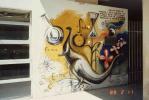 |  |
| Högskolan Managua 3 | Leon library 2 | Leon library 3 | Leon library |
 |  |  |  |
| UCA masters projekt | UCA taket 1 | UCA taket 2 | UCA taket 3 |
Spegeltester i Gusums nedlagda blixtlåsfabrik
 |  | 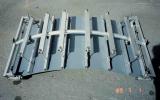 |  |
| Tomas, Ylva, Amanda | Trehjulingen spegel 1 | Trehjulingen spegel 2 | Spegel 1 fokuseras |
 |  |  |
| Tomas | Ambjörn | Tomas smälter sten |
 |  |
| Släpkärran överdel | Släpkärran underrede |
Trehjulingen i brännartagen
Släpkärran i brännartagen
Soft Point Focus, Tryggerstiftelsen 1992
//////////// Soft Point Focus ( 10 bilagor ) Ansökan till Tryggerstiftelsen 1992
Personlig bakgrund
Mitt namn är Ambjörn Naeve. Jag är född 1947, tog studentexamen 1966 och civ-ing-examen 1972 på KTH (teknisk fysik). Under åren 1967 - 90 var jag verksam som lärare i matematik vid KTHs matematiska institution (assistent, vikarierande universitetslektor och adjunkt) - med undantag för åren 1974 - 78 , då jag för det mesta befann mig på resande fot (bl.a. i Afrika, Indien och Amerika). Sedan 1985 innehar jag en (1/2 tid) forskartjänst i datorgeometri på KTH/NADA/CVAP (the Computer Vision and Active Perception research group) under ledning av professor Jan-Olof Eklundh (bilaga 10). Denna verksamhet har lett mig fram till en doktorsavhandling inom datalogi (specialområde: ytors form och geometriska modellering på dator), som kommer att presenteras under våren 93. Avhandlingen består i princip av två delar: Dels ett matematiskt "bakgrundsarbete" inom geometri - i syfte att återuppliva en hel del användbara (men antagligen utdöda) geometriska begrepp , som t.ex. "fokal-ytor" och "absoluta developabler", dels några exempel på hur man kan tillämpa sådana begrepp för att både representera ytor samt analysera deras form på ett beräkningsmässigt stabilt sätt.
Sedan 1983 driver jag även mitt eget konsultbolag (Dialectica AB) som sysslar dels med problemlösning och kursverksamhet inom industrin - med kunder som t.ex. C.E.Johansson, Ericsson och Televerket - dels med teknikutveckling i egen regi. Denna senare del av verksamheten innefattar för närvarande framförallt solenergi och holografi och bedrives i samarbete med en forskarkollega och nära vän vid namn Lloyd Cross som är verksam i San Francisco.
Lloyd Cross är utbildad som fysiker vid University of Michigan (Ann Arbour) och han är en välkänd forskare och uppfinnare inom det optiska området. Han var t.ex. en av dem som uppfann (upptäckte!) lasern, och han har under 60- och 70-talet utvecklat viktiga principer och metoder för framställning av olika typer av hologram, bl.a. rörlig holografisk film (s.k. integral- eller multiplex-holografi). Under 80-talet har Lloyd Cross utvecklat en dator-baserad holografisk kamerateknik som bl.a. har använts för att producera "holografiska linser" (s.k. Holographic Optical Elements) samt "precisionsmätningshologram" för s.k. holografisk interferometri.. Den senaste uppskjutningen av den amerikanska rymdfärjan innehöll t.ex. ett av Lloyds mäthologram - avsett att kvantifiera studiet av kristallers tillväxt i en gravitationsfri miljö.
Under åren 1976 - 78 arbetade jag i San Francisco tillsammans med Lloyd bl.a. med utveckling och förbättring av hans kamerasystem för framställning av rörlig holografisk film (en s.k. multiplex-printer). Detta samarbete lade grunden för en djup intressegemenskap inom geometri med inriktning på hur man skapar, beskriver och presenterar bilder av intressanta geometriska former och föremål på ett så informativt och levande sätt som möjligt.
Projektbeskrivning - bakgrund
Det projekt som här ska beskrivas berör i första hand området solenergi men har även viktiga kopplingar till holografi. Projektet startade i själva verket för snart 16 år sedan i San Francisco (nov 1976), då Lloyd och jag tillsammans upptäckte ett nytt sätt att koncentrera strålningsenergi "en dimension i taget" - den s.k. "dubbelcylindriska punktfokusprincipen" (bilaga 1). Efter en hel del funderingar valde vi att inte ta patent på vår upptäckt. Detta var inget enkelt beslut att fatta eftersom vi insåg att det förmodligen skulle komma att väsentligt försvåra utvecklingen av vår idé till en färdig produkt. Som resultat av en patentansökan i informationssyfte 13 år senare (bilaga 2) har det dock visat sig att patentläget för själva grundprincipen var "hopplöst" eftersom samma princip hade patenterats inom det elektromagnetiska antenn-området - ungefär vid samma tidpunkt då vi "upptäckte" den!! (bilaga 3).
Detta innebär dock ingalunda att den optiska tillämpningen av den dubbelcylindriska punktfokusprincipen är ointressant - tvärtom! Vår "punktfokus-metod" har nämligen två synnerligen väsentliga fördelar - i jämförelse med den "klassiska" rotations-paraboloiden: För det första är det förhållandevis enkelt att framställa cylindriska speglar i större storlekar - eftersom man kan böja plana speglar och trimma in dem mot sin ideala form. För det andra är det enkelt att förlägga fokalpunkten till området utanför de båda speglarna - där den är fritt tillgänglig för att uträtta arbete av olika slag (bilaga 1, sid 5).
Efter min återkomst till Sverige 1978 försökte jag under flera år att få kontakt med människor som hade intresse och kunskaper för att arbeta med vidareutveckling av "energiskottkärran". Jag höll en mängd föredrag, och presenterade den i alla möjliga sammanhang. Efter 7 års sökande fick jag år 1985 (genom ett av mina föredrag) kontakt med en metallhantverkare i Gusum vid namn Tomas Elofsson. Han tände tillräckligt på "energi-skottkärrans teknologi" för att satsa sin egen tid och kunskap. Två år senare kom han tillbaka med en dubbelspegel på 120 x 80 cm (den största spegelns mått) som han byggt på sin fritid i sin egen metallverkstad - en vidareutveckling av Lloyds och mina design-idéer. I detta läge vände vi oss till stiftelsen Futura och erhöll stöd med 100.000 kr för utveckling av en större punktfokuserande spegel som vi döpte till "energisläpkärran", eftersom den var tänkt att kunna dras som en släpkärra bakom en bil. Med hjälp av ytterligare c:a 150.000 kr från mitt eget företag (Dialectica) har vi kunnat slutföra själva grundkonstruktionen och vi har idag en färdig energisläpkärra med en primärspegel på 300 x 200 cm. Det återstår dock en del arbete på att förbättra själva fokuseringsmekanismen. Tyvärr har vi inga fotografier av den färdiga konstruktionen, men jag bifogar ett foto av den grundläggande ramkonstruktionen (bilaga 4, bild 1). Vid ett besök hos mig på KTH den 22/1 - 92 har dock de till stiftelsen knutna professorerna Göran Borg, Bengt Rånby och Olle Lindström haft tillfälle att studera den färdiga energisläpkärran på video. Detta videoband kan för övrigt lånas från mig när som helst (per telefon 790 6642 eller 714 9242).
Parallellt med konstruktionen av energisläpkärran har vi även utvecklat en mindre variant kallad "energitrehjulingen" (primärspegel: 150 x 100 cm) (bilaga 4, bild 2). Detta har delvis skett inom ramen för ett solenergisamarbete mellan KTH och Nicaragua (Tekniska högskolan i Managua) (bilaga 5) men även genom stöd från Dialectica. Genom detta arbete har vi kunnat förbättra fokuseringsmekanismerna högst avsevärt - vilket vi kunnat dra nytta av även för energisläpkärran. Det kan nämnas att vi i höstas (okt 91) lyckades smälta krita ( 2580 °C) med energitrehjulingen - vilket även förevisades på video vid stiftelsens besök på KTH.
Projektbeskrivning - Soft Point Focus
Av ovanstående bakgrundsbeskrivning torde framgå att vi idag behärskar speglarnas fokuseringsteknik relativt väl - när det gäller att åstadkomma ett så koncentrerat fokus som möjligt. För att vår energikoncentrationsmaskin ska bli tekniskt användbar krävs det emellertid att man kan koncentrera ljuset på ett "jämt fördelat sätt" - dvs utan att erhålla lokala koncentrationstoppar (s.k. "hotspots"). Ett sådant fokus med jämt fördelad energitäthet kommer vi nedan att beteckna som ett Soft Point Focus (SPF). Att kunna åstadkomma ett SPF är av fundamental betydelse för alla tillämpningar i mellantemperaturområdet - som t.ex. ljuskoncentration på solceller för elektricitetsframställning - s.k. HCPV (High Concentration Photo Voltaics). Detta är en teknologi som på senare år har uppvisat klara förutsättningar att kunna ta steget ut från forskningslaboratorierna till en kommersiell produkt på energimarknaden (bilaga 6). Det är följaktligen för att kunna utveckla teknik för att framställa ett Soft Point Focus som jag nu ansöker om projektmedel från Carl Tryggers Stiftelse.
Arbetet kommer att bedrivas i nära samarbete med Lloyd Cross och det har egentligen redan inletts. Under de senaste tre åren har vi nämligen tagit fram ett datorprogram för att kunna specialstudera olika optiska konfigurationer interaktivt. Programmet (kallat Holotrace) erbjuder även möjlighet att inkludera holografiska optiska element (HOEs) i strålgången - vilket utgör en synnerligen intressant möjlighet att åstadkomma kontrollerad vinkelspridning av ljuset i smala sektorer. Tanken är här att belägga varje spegelyta med ett selektivt diffuserande skikt - framställt på holografisk väg - som sprider ljuset lagom mycket (en dimension i taget).
En annan möjlighet - som kan kombineras med HOE-diffusion - är att ersätta de plana speglarna med plana strips (bilaga 2, fig 3). Detta ger i sig en viss "utsmetning" av fokus - som dessutom kan kombineras med HOE-diffusion för ytterligare utjämning av energitätheten.
Det bör även nämnas att de teoretiska arbeten om fokalytors geometri som ingår i min kommande doktorsavhandling utgör en naturlig teoretisk grundval för ett Soft Point Focus projekt. Jag har nämligen studerat olika avvikelser från den dubbelcylindriska punktfokuskonfigurationen - i syfte att via reflektion av en plan vågfront generera vågfronter med olika former av symmetri. I samband härmed har jag tillsammans med Johan Appelgren utvecklat ett simuleringsprogram (kallat S-reflections) där vågfronter och deras fokalytor kan studeras på ett interaktivt sätt. Programmet är uppbyggt i en avancerad kombinationsmiljö av beräkningskraft och grafik (på en s.k. Lisp-maskin av märket Symbolics) vid KTHs Bild och Grafik Laboratorium. En del bildresultat från simuleringar med S-reflections bifogas (bilaga 7, 8, 9). Dessa båda program (Holo-trace och S-reflections) kompletterar varandra och utgör tillsammans en synnerligen kraftfull simuleringsmiljö för att studera olika möjliga Soft-Point-Focus-konfigurationer och jämföra dem med varandra.
Projektplan och budget
För ett par dagar sedan återkom jag från ett två veckor långt arbetsbesök hos Lloyd Cross i Kalifornien där vi bl.a. diskuterade uppläggningen av ett Soft Point Focus projekt. Som vi ser det i nuläget innehåller projektet följande huvuddelar:
1. Diskreta spegel-strips (med och utan extra diffusionselement). 2. Selektiv diffusion på kontinuerliga spegelytor (HOE-diffusion genom ytbeläggning (coating) eller tryck-teknik (embossing). 3. Distortion (formförändring) av kontinuerliga spegelytor (teoretiska studier och datorsimuleringar). 4. Allmän design-studie av tilläggsdiffusorer (t.ex. framför strålkällan).
De centrala punkterna i detta skede är punkt 1 – 3, medan punkt 4 utgör en naturlig påbyggnad av projektet. Vi måste naturligtvis även ta hänsyn till den tänkta mottagar-konfigurationen för vårt SPF. Vår primära tillämpning är HCVF (som nämnts ovan) men även s.k. "heat transfer absorbers" (för högtemperaturtillämpningar) och direkta (= värme-mekaniska) motorer av olika slag är tänkbara. På sikt är det även möjligt att kombinera sådana tillämpningar parallellt genom att utföra holografisk separation av den instrålande energin (med hjälp av HOE-teknik). Lloyd har redan utvecklat likartad teknik och tillverkade nyligen ett holografiskt sinus-filter med 90% optisk verkningsgrad och mindre än 3% harmonisk distortion (= avvikelse från den önskade sinus-formen på franstäthetsfunktionen).
Vi räknar med att kunna framställa ett Soft Point Focus med en solkoncentration på mellan 1000 och 3000 gånger med ytterst jämnt fördelad energitäthet (c:a 100 kW/m2). Detta kan jämföras med ett vanligt paraboliskt linjefokus (dvs en ensam parabolisk cylinder) som kommer upp i en solkoncentration på c:a 30-50.
Projektbudgeten kan av naturliga skäl ej bli särskilt detaljerad vid denna tidpunkt, eftersom den måste bygga på en övergripande uppskattning av de olika delarnas kostnader.
Kostnadsslag Kronor
Lönearbete * 100.000
Materiel 70.000
Dokumentation 10.000
Diverse 5.000
=========================
Totalkostnad: 185.000
(* Det bör påpekas att i enlighet med Trygger-stiftelsens stadgar ingen lön är avsedd att utgå tlll någon doktorand).
Det är min förhoppning att Trygger stiftelsen finner möjlighet att bevilja ovanstående medel i enlighet med denna ansökan, och därigenom stödja ett projekt som är av både teoretiskt och praktiskt intresse - inte minst för utvecklingen av framtida svenska produkter inom energiområdet.
Stockholm 1/6 1992
Ambjörn Naeve
///////////
In the following letter of ⚠ 1992-11-23 (Beviljande från Tryggerstiftelsen), the Trygger Foundation expressed its approval of the above application for funding of the Soft Point Focus project. It was great news, and Lloyd was enthusiastic when I told him about it on the phone.
During the following year we did some good work with the SPF, some of which is described below in the first part (report of the work done) of the application for renewed funding of the Soft Point Focus project that was submitted to the Trygger foundation on June 1, 1993.
//////////// Soft Point Focus - extension (Application to the Trygger Foundation 1993):
This is an application for an extension of the Soft Point Focus Project granted by the Trygger Foundation according to my application of ⚠ 1992-06-01. The project was started in June 1992 on a contingency basis, and continuous work has been going on since the beginning of 1993. What follows is a condensed version of the final report that will be submitted when the first phase of the project is finished in August 1993.
Report of the work done during the first pahse of the Soft Point Focus project
Time Cost Work Done Results
1992 3040 $ Installing solar tracker. Laboratory setup. Simulating the coma of Holotrace simulations. the focused solar image.
Jan 93 2000 $ Design study for the New design of edge experimental point focus. torque mirrors.
Febr. 93 3000 $ Study of optical/mechanical Decision to proceed diffusion methods for with continuous surfaces. continuous and segmented Decision to investigate surfaces. mechanical and "hot" diffusion.
March 93 4500 $ Optimizing design Decision to use tracker for of point focus and tracker / low power studies and concentrator configuration. combination structure for high power.
April 93 4570 $ Fabrication of 2 steel See forthcoming mirrors for field testing. final report.
May 93 invoice Tuning of mirrors See forthcoming pending and assembly of final report. experimental apparatus in combining structure. Fabrication of HOE hot diffusor.
Summarizing the above, we have at present used up about 165000 SEK from the 185000 that was granted by the foundation. The most important results during this phase have been:
1) The design and fabrication of an improved version of a point focus which we consider to be necessary for the detailed study of controlled diffusion. This more flexible design was adapted for both theoretical and practical reasons. In this new method, the mirror sheets are not clamped (i.e. fixed) at the edges, but the curvature is obtained by parallel torque bars with the straight edges optionally allowed to move freely or selectively constrained.
2) The decision to concentrate on the "hot diffusor" approach (i.e. diffusors close to the point focus).
3) Design and fabrication of the first hot diffusor, which will be tested shortly in our experimental apparatus.
Moreover, we should mention that the discrete mirror strips (discussed under point 1 of the application of last year) have been ruled out at this point due to the high projected costs of an experimental apparatus as well as the extensive amount of computer time required in order to obtain meaningful simulation data.
Phase 2 of the Soft Point Focus project - Project Plan and Budget
Based on the knowledge aquired during phase 1, we see the structure of the next phase of the project in the following way:
1) We will concentrate on the continuation of the HOE hot diffusor exploration as well as various forms of mechanical and acoustical optical surface deflections. It should be mentioned that the theoretical groundwork for exploring the shape distortions of the continous mirror deformations has been completed and presented in the form of a doctoral thesis (May 29, 1993), which is submitted as an appendix to this application.
2) We will explore the use of HOE devices to optimize the spectral input to HCPV cells in order to reduce heat loading and UV degradation.
3) We will continue to explore the concepts of input optical screen diffusors and optical surface diffusors.
Type of cost SEK
Wages * 180.000
Materials 40.000
Documentation 10.000
Miscellaneous 5.000
============================
235.000
Moms (25%): 58.750
============================
Total cost: 293.750
(* No wages will be paid to any doctoral student).
It is my hope that the Trygger Foundation will find it possible to grant the means for a continuation of the Soft Point Focus project in accordance with the specification presented above. As the final report of phase 1 will demonstrate, the results obtained so far constitute a promising body of knowledge which well merits a further exploration of this subject.
Stockholm June 1, 1993
Ambjörn Naeve
////////////
Simulations in Holotrace for the Soft Point Focus project
 |  | 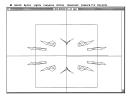 |  |
| SoftPointFocus 1 | SoftPointFocus 2 | SoftPointFocus 3 | SoftPointFocus 4 |
Solar Horse Power (Soldrivna hästkrafter), Gunnarskog 1995
 |  |  |  |
| Energitrehjulingen | Energsläpkärran | Solenergikonsulter | Titelsida 28 juli 1995 |
De har solkraften som smälter berg, Värmlandsbygden, 28 juli 1995
Skall Arvikaföretag få tillverkningen av koncentrerad solkraft som smälter berg? ''
Kjell Eriksson tände på solgeneratorn hos Ålanders i Ålbotten, Värmlandsbygden, 4 aug 1995
Referat av samtal med Lars Klintberg, Almi
Almi och NUTEK måste ta sitt ansvar, Värmlandsbygden, 7 juni 1996
Ryytty, C. (Handläggare, Energi och Miljöteknik, NUTEK), Angående er ledare i Värmlandsbygden 7 juni 1996
Naeve, A., Kommentar till NUTEK
Ylvas brev till miljöminister Anna Lindh
Cybermath 2000
Taxén, G., Naeve, A., CyberMath - Exploring Open Issues in VR-based Learning, SIGGRAPH 2001
Taxén, G., Naeve, A., CyberMath: A Shared Virtual Environment for Mathematics Exploration, ICDE-2001
Öhman, A., Galen i matte - intervju med Ambjörn Naeve, PC Hemma Mars 2003
Pointfocus Demo Lectures in Cybermath (3 min)
 |
| mirrors |
